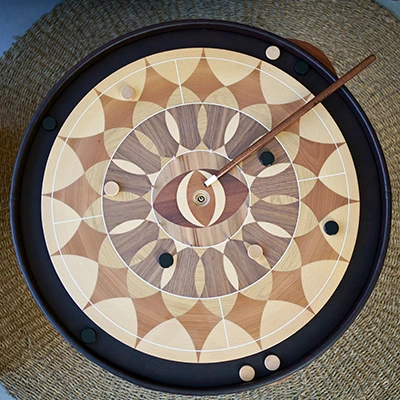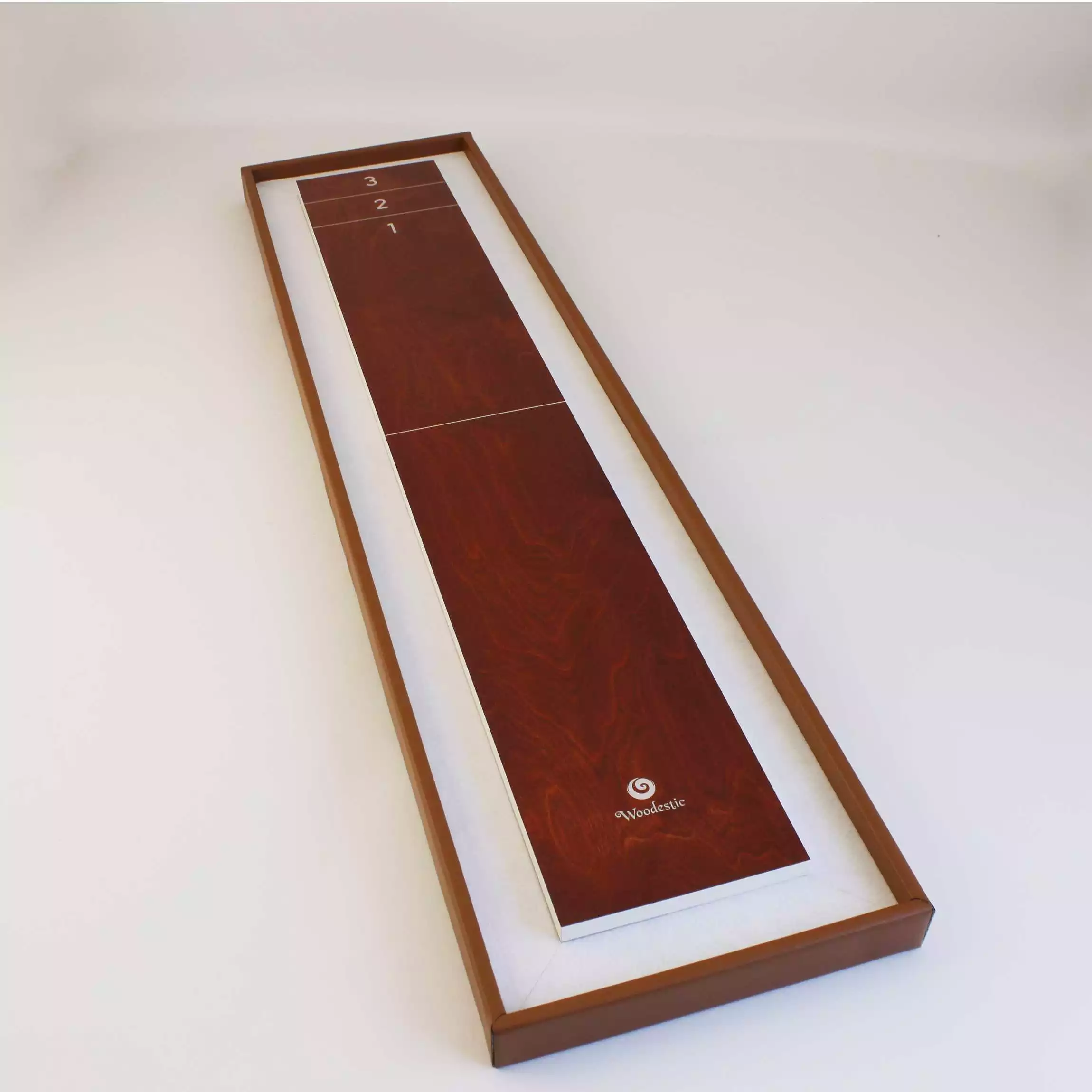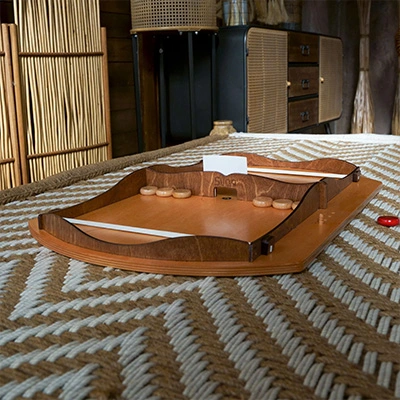




Game rules
Règles du jeu
Spielregeln
- Aim of the game
Players alternately try to flick their discs into the center hole of the round board or into higher value fields. In the flicking fight for points, opposing players will try to hit each others’ discs to knock them out of the playing area or into lower scoring positions.
The player with more points wins the round. Usually more than one round is played to decide which player is the best. According to traditional scoring the player has to collect at least 100 points in one or more rounds to win the game (for scoring details see chapter 7).
- Le but du jeu
Les joueurs (de 2 à 4 personnes) essaient l’un après l’autre de tirer leurs disques en visant le trou central de la planche ronde ou les champs de plus grande valeur. Dans la lutte pour les points, les joueurs opposés peuvent percuter les disques des autres pour les faire tomber hors de la zone de jeu ou dans les champs de valeur inférieure.
The player with more points wins the round. Usually more than one round is played to decide which player is the best. According to traditional scoring the player has to collect at least 100 points in one or more rounds to win the game (for scoring details see chapter 7).
- Ziel des Spiels
Die Spieler kommen nach einander, und versuchen ihre Scheiben ins Mittelloch oder in diese Position zu schnippen wofür Sie die meisten Punkte erlangen. Im Kampf um die Punkte können die Spieler die Scheiben ihrer Gegner in niedrigere Punkt zahl bringenden Gebiete stoßen oder auch vom Spielbrett entfernen.
Das Spiel gewinnt derjenige der zuerst 100 Punkte erreicht. Das Spiel benötigt kein hohes logisches Denken, weder mehrere Stunden Freizeit, nur ein Tisch auf dem man das Spielbrett setz und eine viertel Stunde sind genug um Spaß zu haben. Schnippen kann jeder, so ist es ein passendes Spiel mit Familie oder mit Freunden.
- Basic rules
Commonly Crokinole is played by 2 players. Cooperative 4-playermode is also very popular when two 2-player teams face each other. Also there are rules for 3-player mode (for 3-player game see chapter 9).
The standard Crokinole board is a 66 cm (26”) diameter wooden board with a shallow hole in the center. Players flick small wooden discs on the playing surface into valuable positions. The playing area is divided into 3 scoring fields by concentric circles with increasing values towards the center. There are 8 bumpers around the most inner circle to make it more difficult to flick the discs in the center hole. The most outer scoring filed is divided into four quadrants. Players can only shoot discs from their quadrant. The most outer circle is the shooting line.
Discs landing within the scoring circles are worth 15, 10 and 5 points moving out from inside. A disc falling into the center hole is worth immediately 20 points to its player. Discs leaving the playing area are worth 0 point. The shooting line is also the border of the playing area (see image 1). Players count their points at the end of each round (as detailed in chapter 7).
- Règles de base
Généralement le Crokinole se joue avec deux participants, mais la version coopérative avec 4 personnes est également très populaire. Dans ce cas deux équipes de deux joueurs s’affrontent. Il existe également une version pour trois joueurs (à lire dans la rubrique « Règles spéciales »).
La planche Crokinole standard est une planche en bois de 66 cm de diamètre avec un trou peu profond au centre. Il faut tirer les petits disques en bois sur la surface de jeu dont les positions sont précieuses. La zone de jeu est divisée en 3 champs par des cercles concentriques avec des valeurs croissantes vers le centre. Il y a 8 pare-chocs autour du cercle au milieu pour rendre plus difficile l’accès au trou central dans lequel il faut mettre les disques. Le champ à l’extérieur est quant à lui divisé en quatre quadrants. Attention, les joueurs ne peuvent tirer les disques que de leur
quadrant.
A la fin du jeu, les disques restant dans les champs – du centre vers l’extérieur – valent 15, 10 et 5 points. Un disque qui tombe dans le trou central rapporte immédiatement 20 points à son joueur. Les disques sortant de la zone de jeu valent 0 point. Le cercle le plus extérieur est la ligne de tir. La ligne de tir est également le bord de la zone de jeu (voir image 1.). Les joueurs comptent leurs points à la fin de chaque tour conformément aux “Règles de décompte”.
- Grundregeln
Meistens spielen zwei Spieler, aber die kooperative vier Spieler Variante ist auch verbreitet, indem die zwei Teammitglieder nach dem Sieg streben. Das Spiel kann man auch zu dritt Spielen. (Siehe Zusätzliche Regeln)
Das Crokinole Brett ist ein Holzkreis, mit einem Durchmesser von 66 cm, in der Mitte vom Holzkreis befindet sich ein Loch. Auf dem Brett muss man die Holzscheiben in die Punkte bringenden Positionen schnippen. Das Spielfeld wird von konzentrischen Kreisen in drei Gebiete geteilt, die zur Mitte gehend mehr Punkte bringen. Der innerste Kreis ist mit 8 Pins umgrenzt, so ist der Eintritt der Holzscheiben in dieses Gebiet schwerer. Das äußerste Gebiet ist außerdem in vier Teile geteilt, jeder Spieler darf die Holzscheiben nur von seinem eigenen Viertel starten.
Am Ende vom Spiel haben die sich auf dem Spielfeld befindenden Holzscheiben, von innen nach außen voranschreitend, einen Wert von 15, 10 oder 5 Punkten. Diese Holzscheiben, die bis in das Mittelloch geschossen wurden, erbringen jeweils 20 Punkte. Die Scheiben die das Spielfeld verlassen haben bringen keine Punkte. Der äußerste Kreis ist auch gleichzeitig die Schusslinie und der Rand des Spielfeldes (1. Bild). Die Punktzahl der Spieler muss man nach jedem Spiel laut dargelegten Schritten im Abschnitt „Punkteberechnung“ ausrechnen.
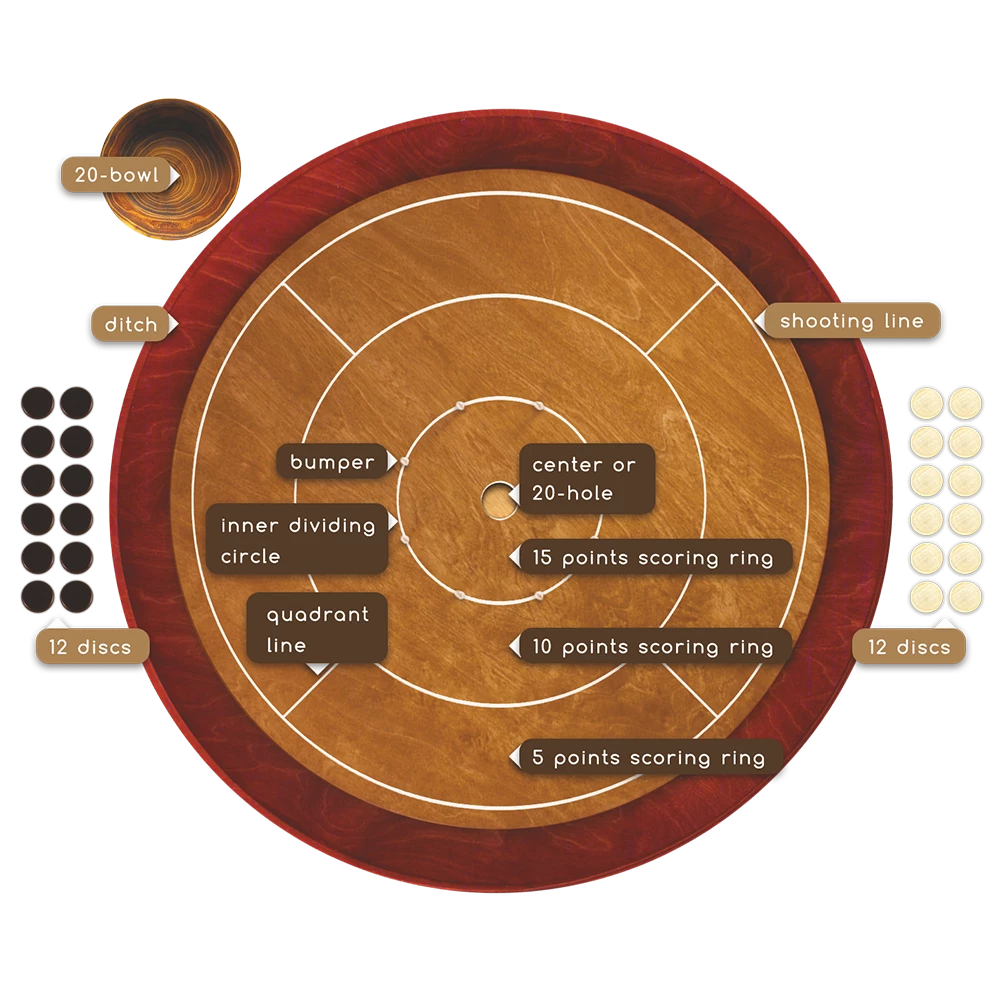
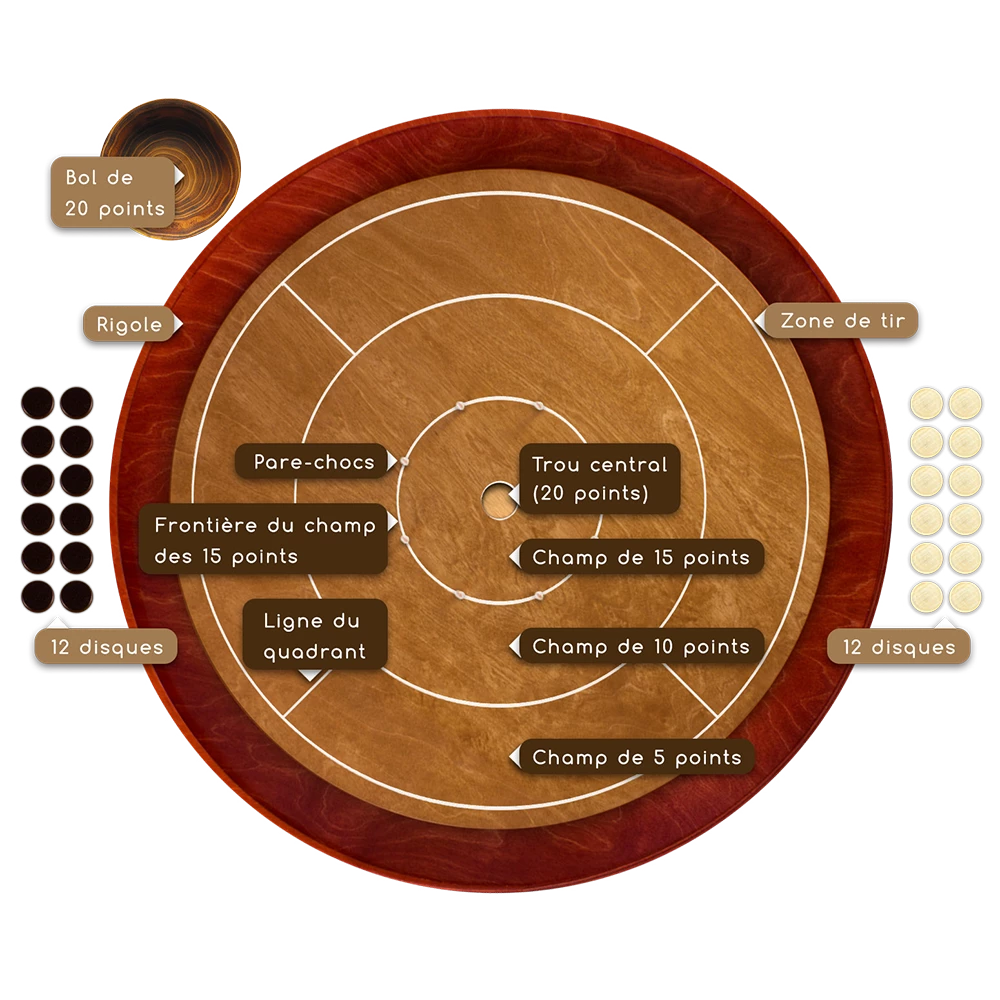
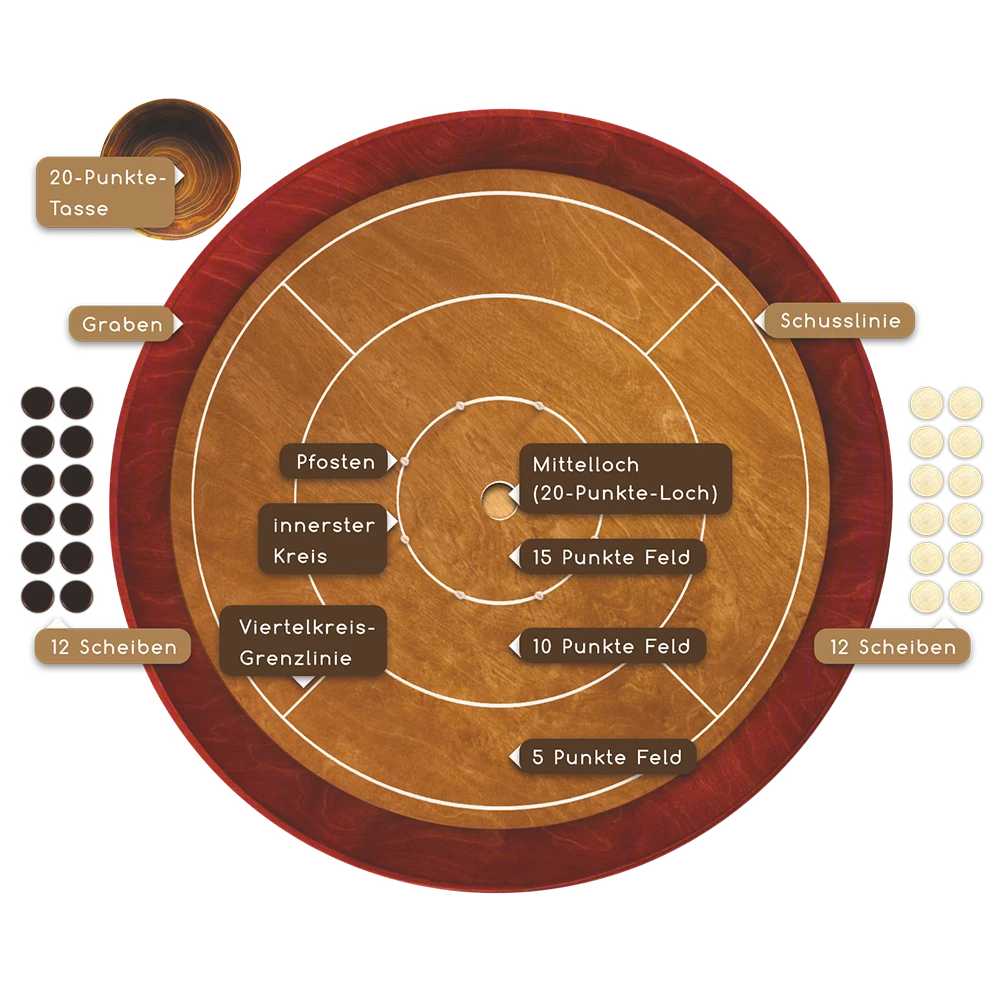
#1.
- Preparing the game
Place your Crokinole board on a table to be comfortable enough for each player to reach his/her quadrant. In the following, the board can not be moved during the game. Place a 20-bowl (e.g. a glass, a cup or bowl – optional accessory!) on the table next to the board. Choose the starting player by any drawing method.
- Préparer le jeu
Placez votre planche Crokinole sur une table de manière à ce que chaque joueur puissent atteindre facilement son quadrant. Par la suite, la planche ne doit plus être déplacée. Placez un récipient pour les 20 points (par exemple: un verre, une tasse ou un bol – pas un accessoire) sur la table à côté de la planche. Choisissez le joueur qui commencera le jeu par tirage au sort.
- Vorbereitungen
Das Brett soll man möglichst waagerecht auf einem Tisch legen, so, dass alle Spieler zu ihren eigenen Viertel bequemlich Zugriff haben. Danach wird die Position des Brettes während dem Spiel nicht mehr geändert. Ein Punktesammler (z. B. Tasse, Glass oder Platte – kein Zubehör) soll auch an den Tisch neben da Brett gelegt werden. Der Startspieler wird durch eine Verlosung ausgewählt.
- Two-player game
In a 2-player game, players are seated in opposing quadrants. Both players receive 12 discs in the choosen color. They alternately flick one disc at a time with one finger aiming at the center hole or at the opponent’s discs. Before the shot, the shooting disc always has to be lying on one of its flat side on the player’s shooting line (disc can touch quadrant lines from either side). Each disc can only be shot once in a round.
Positions ‘A’, ‘B’ and ‘C’ are valid shooting positions. Position ‘C’ is also valid because the disc still touches the quadrant line from outside. Discs placed in ‘D’ and ‘E’ positions are invalid, shot can not be executed from here (see image 2).
- Jeu à deux joueurs
Dans un jeu à 2 joueurs, les joueurs sont assis aux quadrants opposés. Les deux participants reçoivent 12 disques de la couleur de leur choix. Ils tirent chacun un disque, l’un après l’autre, avec un seul doigt, visant le trou central ou les disques de l’adversaire. Avant le coup, le disque doit toujours être mis sur l’un de ses côtés plats sur la ligne de tir du joueur (le disque peut toucher des lignes de quadrant de chaque côté). Chaque disque ne peut être joué qu’une fois dans un tour.
Les disques tirés à partir des positions ‘A’, ‘B’ et ‘C’ sont des coups valides. La position ‘C’ est également valide car le disque touche toujours la ligne extérieure du quadrant. Les disques placés en positions ‘D’ et ‘E’ ne sont pas valides, aucun tir ne peut être exécuté de cette position (voir image 2).
- Zwei-Spieler-Spiel
Während dem ZweiSpieler Spiel nehmen die Spieler an den zwei gegenüber liegenden Vierteln Platz. Beide Spieler bekommen 12 Holzscheiben in der gewählten Farbe, dann schnippen sie nacheinander die Scheiben mit einem Finger. Gezielt wird auf das Mittelloch, oder auf die Scheiben des anderen die sich auf dem Spielfeld befinden. Zu einem Schuss wird die Scheibe so an das Brett gelegt, dass sie die Schusslinie in dem eigenen Viertel des Spielers berührt (sie kann die ViertelkreisGrenzlinie von irgendwelcher Seite berühren). Mit allen Scheiben kann einmal geschossen werden.
Ein Schuss ist regulär, wenn die Scheibe aus die „A“, „B“, und „C“ Positionen gestartet wird. Die „C“ Position ist auch regulär, weil die Scheibe noch die ViertelkreisGrenzlinie berührt. Die Scheiben in den „D“ und „E“ Positionen wurden irregulär gelegt, denn kein Schuss kann von hier gestartet werden.
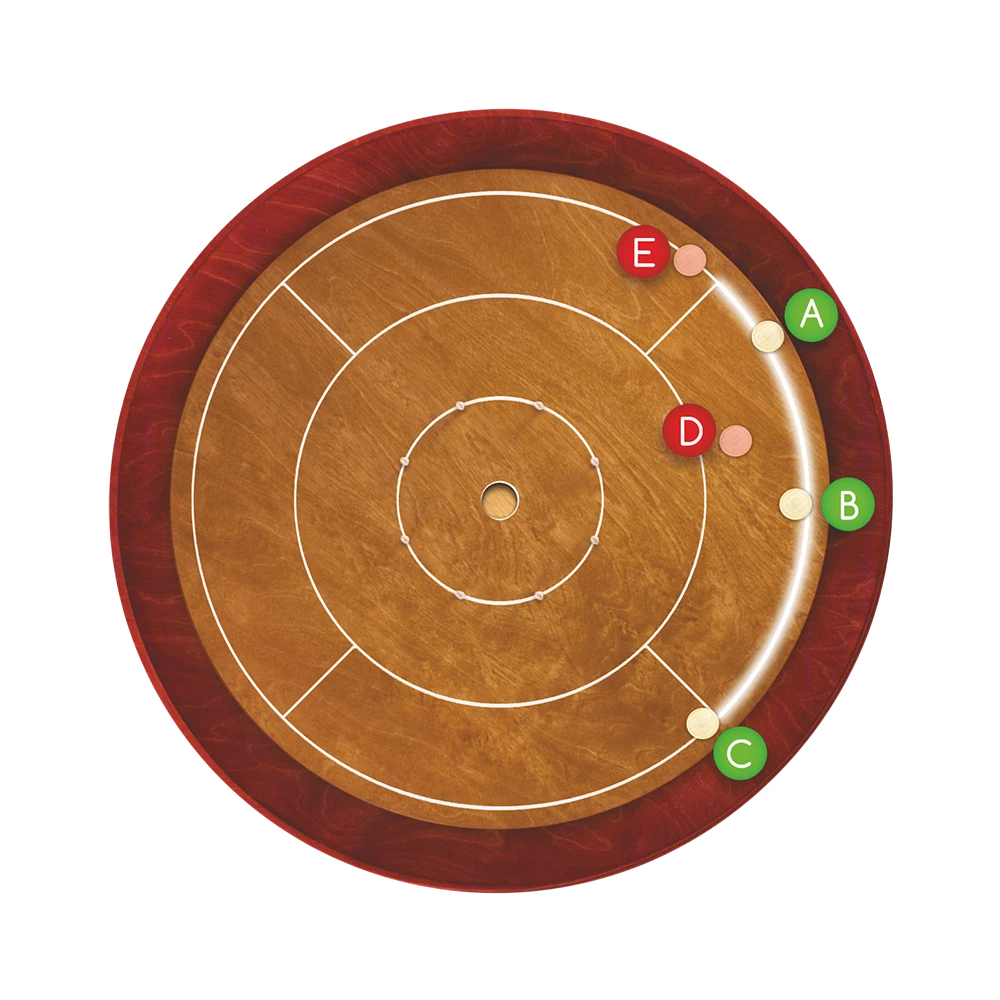
#2.
Free-shot
If there are no opposing discs in the playing area the upcoming player aims into the center hole or in the center scoring field (free-shot). This rule is also applied for the player starting a new round.
If the disc falls into the center hole (meaning the disc is lying completely within the hole) the player places it immediately into a 20-bowl visible to the opponent as well. The value of the discs in the 20-bowl will be added to the final/total score at the end of the round.
When executing a free-shot a disc that stops outside the center hole can only stay on the playing surface if it is within the 15-score field or it is touching the circle of the bumpers. In every other case the disc has to be removed from the game. Eliminated discs must be placed into the ditch framing the board (see image 3)
Coup libre:
Si l’adversaire n’a aucun disque dans la zone de jeu, le prochain joueur peut viser le trou central ou le champ au milieu. Cette règle s’applique également au joueur qui commence un nouveau tour.
Si le disque tombe dans le trou central (c’est-à-dire que le disque est complètement à l’intérieur du trou), le joueur le place immédiatement dans le bol des 20 points. La valeur des disques dans le bol sera ajoutée au total des points à la fin du tour.
D’autre part, le disque qui s’arrête à l’extérieur du trou central ne peut rester dans la zone de jeu que s’il est dans le champ des 15 points ou bien qu’il en touche les frontières. Dans tous les autres cas, le disque doit être retiré du jeu. Les disques éliminés doivent être placés dans la rigole encadrant la planche (ou en dehors) (voir image 3).
Freier Schuss
Wenn der Gegner keine Holzscheibe am Spielfeld hat, kann der darauf folgende Spieler gerade auf das Mittelloch oder in den inneren Kreis zielen („freier Schuss“). Diese Regel ist auch für den Startspieler gültig.
Wenn der Schuss ins Mittelloch trifft (die Scheibe fällt ganz hinein!) muss der Spieler die Scheibe herausnehmen, und in den Punktsammler legen. Der Punktesammler muss von beiden Spielern gut gesehen werden.
Falls die Scheibe außerhalb des Mittelloches anhält, kann sie nur in dem Falle bleiben, wenn sie im 15er Gebiet ist oder dessen Grenzlinie berührt. In jeder anderen Situation ist die Scheibe raus aus dem Spiel und muss vom Brett entfernt werden. Die entfernten Scheiben muss man in den Graben (oder außerhalb des Brettes) legen. (3. Bild)

#3.
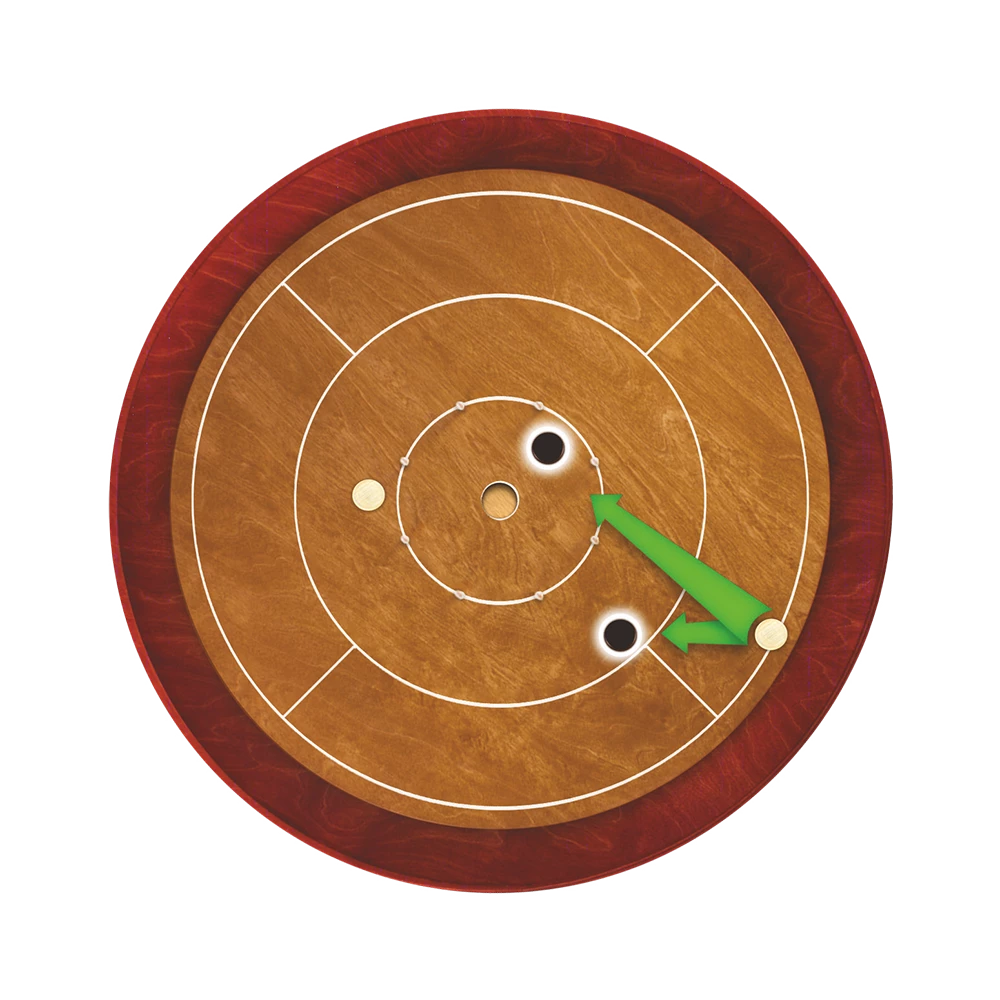
#4.
Striking the opposing discs:
If the opponent has one or more discs in play the next player MUST shoot his/her disc to strike at least one of the opposing discs with any of his/her own discs (see image 4).
Le ricochet :
Si l’adversaire a un ou plusieurs disques en jeu, le joueur suivant doit tirer son disque de façon à ce qu’il touche au moins un des disques opposés avec l’un de ses propres disques (voir image 4).
Die gegnerischen Scheiben schlagen:
Wenn der Gegner eine oder mehrere Scheiben auf dem Spielfeld hat muss der darauf folgende Spieler so schießen, dass eine seiner Scheiben mindesten eine des Gegners trifft. (4. Bild)
If the shooter fails to hit all opposing discs, shooting disc must be removed to the ditch, furthermore every discs of the shooter involved in the shot must also be removed from the playing area (including any discs that have fallen into the center hole).
Striking can also be made indirectly (e.g. by first hitting a bumper or any other disc) by bumping an own disc to the opposing disc (for carom rules see chapter 8).
After collision of at least two opposing discs, they can finish their movements anywhere within the playing area. Only discs that stop touching the shooting line are deemed out of play and must be removed to the ditch.
One round lasts until both players run out of their 12 discs. Any discs that once left the playing area stay out of the game until its end. After this scoring takes place.
Si le joueur ne réussit pas, le disque de tir doit être enlevé de la zone de jeu et doit être retiré dans la rigole. De plus, tous les disques du joueur impliqués dans le tir doivent également être retirés de la zone de jeu (y compris les disques tombés dans le trou central).
Le ricochet peut également être réalisé indirectement; par exemple, en touchant d’abord un pare-choc ou en touchant un disque. (voir Règles spéciales).
Lors d’un ricochet les disques opposés peuvent finir leurs mouvements n’importe où dans la zone de jeu. Les disques touchant la ligne de tir doivent alors être retirés dans la rigole.
Un tour dure jusqu’à ce que les deux joueurs aient mis en jeu leurs 12 disques. Tous les disques qui ont quitté la zone de jeu restent hors du jeu jusqu’à la fin du jeu. Ensuite, le décompte des points a lieu.
Falls das nicht passiert, so wird die Scheibe und alle, die sich vom Schuss bewegt haben vom Spielbrett entfernt. Bei solch einem Schuss wird auch die Scheibe vom Spiel entfernt die ins Mittelloch gefallen ist.
Der Zusammenstoß kann auch indirekt geschehen. Zum Beispiel kann er von einem Pin oder anderen Scheibe verursacht werden. (Siehe Spielregeln: Karambolage)
Nachdem Zusammenstoß können die Scheiben in jedem Feld anhalten und man muss nur die Scheiben vom Spielbrett entfernen, die die Startauslinie berühren.
Eine Runde hält bis beide Spieler alle ihrer 12 Scheiben aufgebraucht haben. Innerhalb einer Runde können die vom Spiel entfernten Scheiben nicht wieder benutzt werden. Danach folgt die Auswertung.
- Four-player game
4-player mode only differs slightly from the above introduced gameplay for two players. The four players are divided into two 2-player teams, teammates facing each other around the board. One team’s 12 discs are divided in half between teammates, so every player will start playing with 6 discs.
Starting player is choosen by any drawing method and players follow in clockwise. Other rules are applied similarly. The round also lasts until all players run out of their discs. After this scoring takes place.
- Jeu à quatre joueurs
Le mode 4 joueurs diffère seulement légèrement du mode de jeu présenté ci-dessus. Les quatre joueurs sont divisés en deux équipes de 2 joueurs, de façon à ce que les membres de chaque équipe soient assis face à face. Les 12 disques d’une équipe sont divisés en deux entre les coéquipiers, de sorte à ce que chaque joueur commence le jeu avec 6 disques.
Le joueur de départ est choisi par tirage au sort et les joueurs se suivent ensuite dans le sens des aiguilles d’une montre. La ronde dure jusqu’à ce que tous les joueurs aient mis en jeu leurs disques. Ensuite, le décompte des points a lieu.
- Vier-Spieler-Spiel
Das Vier Spieler Spiel unterscheidet sich nur in kleinem Maße vom ZweiSpieler Spiel. Die Spieler bilden zwei Teams, so, dass die Partner einander gegenüber um das Brett Platz nehmen. In solchen Fällen bekommen die Spieler 1212 Scheiben je Team, die sie unter einander aufteilen. So wird jeder Spieler 6 Scheiben am Anfang haben.
Der Startspieler wird durch eine Auslosung entschieden, dann folgen die anderen im Uhrzeigersinn. Die anderen Regeln sind gleich, wie im ZweiSpielerSpiel. Ein Spiel dauert so lang, bis alle Scheiben verbraucht wurden, danach folgt die Auswertung.
- Using gliss powder
Due to microscopic roughness of the discs and the playing surface, the slide of the discs can be uneven. To compensate this effect and ensure smoother slide it is recommended to use gliss powder. Spread a pinch of gliss powder in the ditch in front of you. Slightly rub the shooting disc into the powder before flicking. Don’t let too much powder to stick to the disc because it may slow down your shot.
- Poudre de glisse
En raison de l’irrégularité des disques et de la surface de jeu, le glissement des disques peut être inégal. Pour compenser cet effet et assurer un glissement plus lisse, il est recommandé d’utiliser de la poudre de glisse. Ajoutez une pincée de poudre de glisse dans la rigole devant vous (ou dans un bol en dehors de la zone du jeu). Saupoudrez légèrement le disque dans la poudre avant de le faire glisser. Attention, dans ce cas même un coup léger peut faire traverser la planche à votre disque!
- Rutschpulver
Wegen den feinen Ungleichmäßigkeiten der Scheiben und des Brettes ist das Rutschen nicht immer gleich. Um das Problem zu beseitigen und das gleichmäßige Rutschen zu sichern kann man Rutschpulver benutzen (man muss es extra kaufen). Streuen sie Rutschpulver in den Graben (oder in ein anderes Geschirr außer-halb des Brettes) mit ein oder zwei Prisen, dann reiben sie die Scheibe mit dem Pulver vor dem Schuss ein. Achtung, in solchen Fällen kann ein schwächerer Schuss auch leicht über das Brett brettern!
- Scoring
Scoring takes place after players have shot all their discs. A player/team counts every disc within the shooting line adding any discs in the 20-bowl. Every disc can only be counted once.
Each disc in the 20-bowl is worth 20 points. Discs within the bumpers line are worth 15, 10 outside the bumpers and 5 in the outer scoring ring (see image 5). All discs in the ditch are worth 0 points. Any discs touching a separating line of a circle is counted at the value of the lesser cirlce. Of course discs touching the shooting line after the last shot must also be counted 0 points.
- Décompte des points
Le décompte des points a lieu quand les joueurs n’ont plus de disque. La valeur des disques (d’un joueur/d‘une équipe) dans le bol des 20 points s’ajoute à la valeur des disques présents dans les champs valides. Les disques ne peuvent être comptabilisés qu’une seule fois.
Les disques à l’intérieur de la ligne des pare-chocs valent 15 points, ceux à l’extérieur des pare-chocs valent 10 points et ceux dans le champ extérieur du jeu valent 5 points. Chaque disque dans le bol des 20 points vaut 20 points. (voir image 5) Tous les disques touchant une ligne de séparation d’un champ sont comptés à la valeur du champ inférieur. Bien sûr, les disques touchant la ligne de tir doivent être retirés dans la rigole et valent 0 points.
- Auswertung
Wenn alle Spieler ihre Holzscheiben verbraucht haben, folgt die Auswertung. Bei der Auswertung muss man die Scheiben je Spieler/ je Team zählen, die man ins Mittelloch geschossen hat, oder die, die in den Punkte bringenden Gebieten liegen. Jede Scheibe darf man nur einmal in der Auswertung einbeziehen.
Die Scheiben, die innerhalb der Pins legen, bringen 15 Punkte, die im mittleren Gebiet liegen, bedeuten 10 Punkte, und die im äußersten Gebiet liegen sind 5 Punkte Wert. Die Scheiben, die man aus dem Mittelloch beim Spiel in den Punktesammler gelegt hat, sind 20 Punkte Wert. (5. Bild)
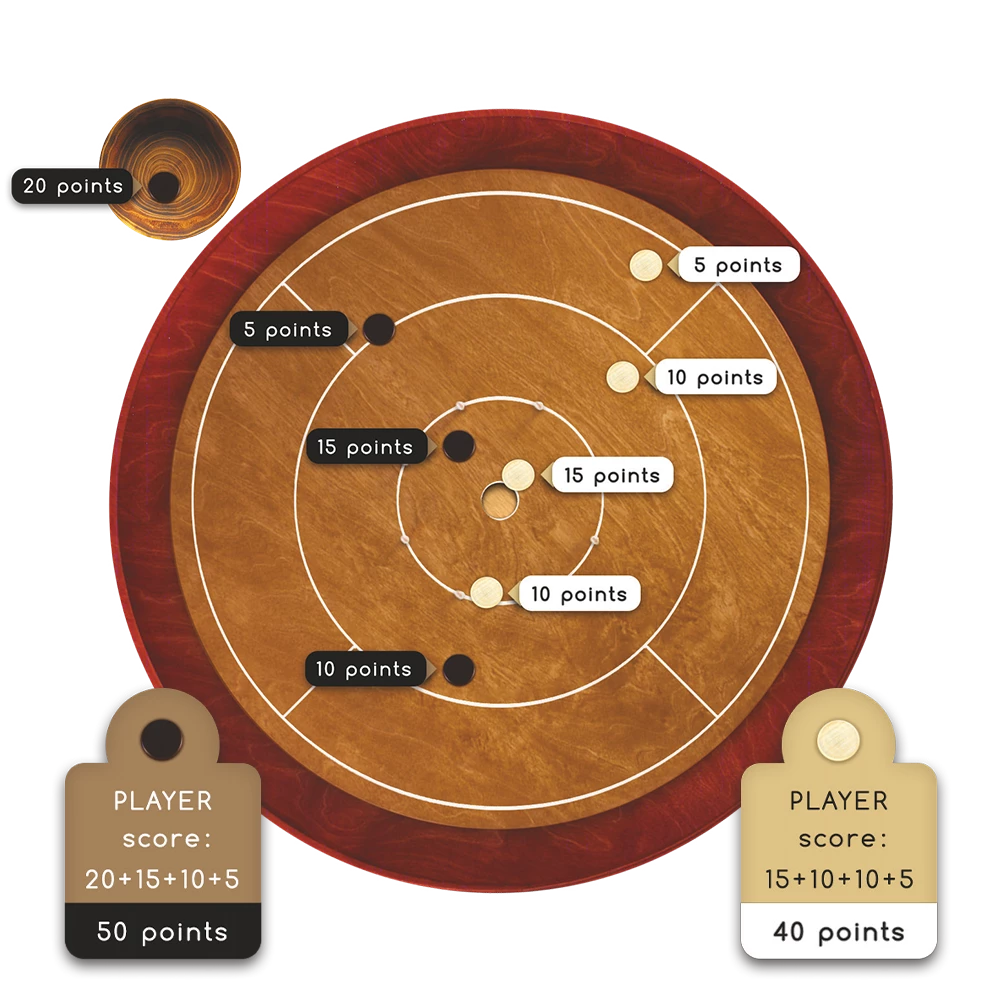
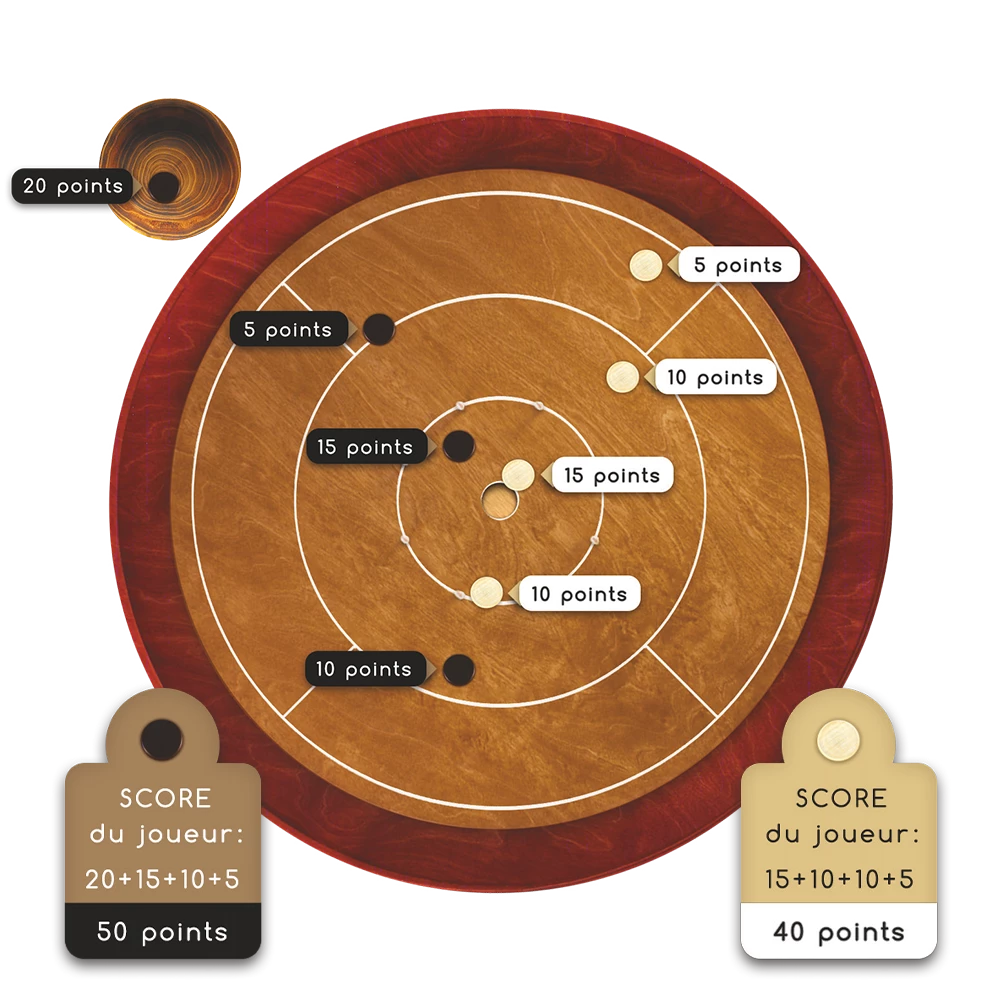
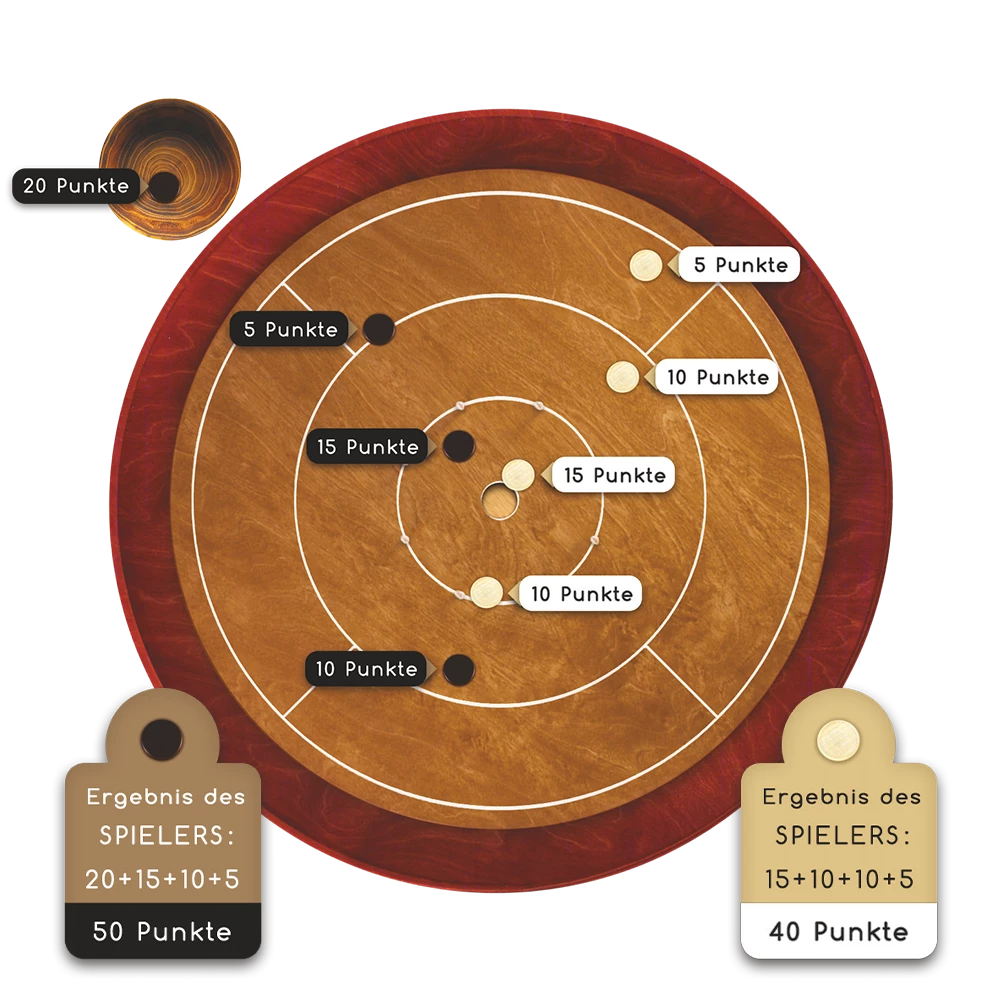
#5.
Traditional scoring (differential and simple):
To win the game a player/team must collect at least 100 points in one or more rounds. The result of a round should be added to the scores of the previous rounds. Use a piece of paper and pen to esier follow up.
The commonly used differential scoring means that the score of the losing player/team is subtracted from the winnig score and the result is recorded for the winner. In case of a tie both parties get 0 points. Simple scoring means the scores are recorded per player/team and no substraction occurs.
Championship scoring:
When scoring on a championship the player/team with higher points receive 2 points and the losing player/team receives 0 points. In case of a tie both parties receive 1 point. Also every 20 shot is counted separately after avery round (for more details visit www.worldcrokinole.com).
Le score traditionnel (différentiel et simple) :
Pour gagner la partie, un joueur/une équipe doit collecter au moins 100 points lors d’un ou plusieurs tours. Le résultat d’un tour doit être ajouté aux scores des tours précédents. Utilisez une feuille de papier et un stylo pour suivre plus facilement.
La méthode de notation différentielle couramment utilisée signifie que le score du joueur/équipe perdant est soustrait du score gagnant, et le résultat est enregistré pour le gagnant. En cas d’égalité, les deux parties obtiennent 0 points. La méthode de notation simple signifie que les scores sont enregistrés par joueur/équipe sans aucune soustraction.
Score du championnat (Décompte des points simple):
Lorsque l’on marque dans un championnat, le joueur/l’équipe ayant le plus de points reçoit 2 points, tandis que le joueur/l’équipe perdant reçoit 0 point. En cas d’égalité, les deux parties reçoivent 1 point. De plus, chaque série de 20 coups est comptée séparément après chaque tour (pour plus de détails, consultez www.worldcrokinole.com).
Differential-Punktrechnung:
Um das Spiel zu gewinnen, muss ein Spieler/ein Team in einer oder mehreren Runden mindestens 100 Punkte sammeln. Das Ergebnis einer Runde sollte zu den Punkten der vorherigen Runden hinzugefügt werden. Verwenden Sie ein Stück Papier und einen Stift, um die Verfolgung zu erleichtern.
Die häufig verwendete Differenzpunktzahl bedeutet, dass die Punktzahl des verlierenden Spielers/Teams von der Gewinnpunktzahl abgezogen wird, und das Ergebnis wird für den Gewinner aufgezeichnet. Im Falle eines Unentschiedens erhalten beide Parteien 0 Punkte. Bei der einfachen Punktzählung werden die Punkte pro Spieler/Team erfasst, und es erfolgt keine Subtraktion.
Meisterschaftswertung:
In einer Meisterschaft erhält der Spieler/das Team mit den höheren Punkten 2 Punkte, und der verlierende Spieler/das verlierende Team erhält 0 Punkte. Im Falle eines Unentschiedens erhalten beide Parteien 1 Punkt. Außerdem werden nach jeder Runde alle 20 Schüsse separat gezählt (für weitere Details besuchen Sie www.worldcrokinole.com).
If you are new to Crokinole, stop reading here!
Let the flicking begin!
Si c’est votre première partie du Crokinole, arrêtez de lire ici et commencez le jeu!
Bonne partie!
Wenn Sie neu zu Crokinole sind, stoppen Sie hier lesen!
Das Spiel kann beginnen!
- Special rules
The following rules are for special cases occuring more rarely. You may look up the required rules when the event occurs during the game.
Carom or indirect strikes:
If any opposing discs are in play, but the player can not (or do not want to) hit an opposing disc directly, he/she may strike an own disc to the opposing disc to achieve a valid shot (carom). The order of the strikes is inessential. If a valid shot is not made then the shooter’s disc and all the other discs of the same color that were struck, including any 20’s, shall be removed from play.
If there is no opposing disc in play, you may carom your own discs towards the center hole. In this case the shot is only valid if at least one of the shooter’s discs falls into the 20-hole or stays within the inner circle or touching the bumper’s line. If none of the moving discs gets into the middle circle (or touches its line) they all must be removed to the ditch.
Almost 20-point shot:
A disc leaning on the edge of the center hole or halfway overturned into the hole must stay in its place, it is not worth 20 points. If it stays there till the end of the game/round value of the disc is only 15. In the middle of the game an almost 20-point disc can be struck out or pushed into the center hole. Only the flat lying discs can be removed to the 20-bowl and counted as 20 points.
20 points for the opponent:
An unfortunate shot can result in striking one of the opponent’s disc into the center hole. Due to strike between opposing discs this shot is always valid and 20 points goes for the opponent.
Returning discs (damage rule):
An out-of-bound disc reentering the playing area (e.g. ricocheting from the rail) is considered to be out of play and must be removed after its movement stops. Any discs that were hit by the re-entering disc must stay in their new position (20-disc is counted as well).
Line or not line?:
Whenever it is difficult to decide if a disc is touching a line or not, ‘look under’ the disc! If clean board can be seen between the edge of the disc and the mentioned line then the disc is not touching it.
Longer or shorter games:
If you have less time to play Crokinole, play until lower total points using traditional scoring. The player/team that reaches at least 50 points first is the winner. For longer gameplay aim for higher total points (e.g. 150 or 200 points). Both differential or simple scoring can be used with these variations. You may also play with less discs. Using championship scoring can easily define the lenght of a game. Win 2 rounds out of 3 played for a really quick game or use the international WCC scoring table for longer games.
Other rules:
- Players (especially the shooting player) must not move and can not leave their chairs to gain better position.
- Using traditional scoring if both teams reach or pass the scoreline required to win the game, the winner will be the one who passes the scoreline with more points. If it is a tie both teams win – if this occurs it is advised to start a new game to decide.
- When starting a new round two rules may be applied to choose starting player: A) The next player sitting clockwise from the previous starting player starts the next round. B) The losing player/team decides whether he/she wants to start the new round or not. (After a tied round only ‘rule A’ can be used.)
- Règles spéciales
Les règles suivantes s’appliquent aux cas spéciaux qui ne se produisent que rarement. Vous pouvez toujours consulter les règles pendant le jeu.
“Ricochet” ou choc indirecte :
Si le joueur ne peut pas, ou ne veut pas, percuter un disque adverse directement, il peut percuter son propre disque sur le disque adverse pour avoir un tir valide. S’il n’y a pas de disque opposé en jeu, un ricochet n’est valide que si l’un des disques termine son mouvement soit dans le trou des 20 points, soit dans le champs des 15 points (ou touche sa ligne). S’il y a un ou plusieurs disque(s) adverse(s) en jeu, le tir n’est valable que si l’un des disques du tireur percute au moins un disque de l’adversaire. Sinon, le tir n’est pas valable, tous les disques impliqués dans les colisions doivent être retirés dans la rigole (y compris le disque dans le trou des 20 points).
Tir de « presque » 20 points :
Un disque à moitié renversé dans le trou ne vaut pas 20 points. Il doit rester à sa place. A la fin du jeu la valeur du disque est seulement de 15 points, sauf si, au cours du jeu il est poussé dans le trou central par un autre disque. Dans ce cas, il doit être retiré dans le bol des 20 points. Un disque qui tombe dans le trou mais ressort aussitôt ne vaut pas 20 points.
20 points pour l’adversaire :
Lors d’un coup malchanceux, un disque de l’adversaire peut être poussé dans le trou central. Ce coup est systématiquement considéré comme valide et le disque peut être ajouté au bol des 20 points.
Disques retournés :
Un disque qui (pour n’importe quelle raison) quitte la zone de jeu et revient dessus immédiatement, doit être retiré. Si le disque retournant touche d’autres disques, les disques touchés doivent rester dans leurs nouvelles positions (il ne faut pas les remettre dans leurs positions originales).
Ça touche la ligne? :
S’il est difficile de décider si un disque touche une ligne ou non, soulevez le disque! La seule chose qui compte c’est que le bord du disque ne touche pas la ligne.
Jeux plus longs ou plus courts :
Si vous avez moins de temps pour jouer, jouez seulement jusqu’à 50 points. Le premier joueur/la première équipe à atteindre au moins 50 points gagne la partie. Pour un jeu plus long, augmentez simplement le nombre total de points à atteindre à 150.
Autres règles :
- Le joueur qui tire ne peut ni bouger sa chaise ni la quitter pour gagner une meilleure position.
- En cas de décompte traditionnel, si les deux équipes atteignent ou dépassent le score requis pour gagner le match, le gagnant sera celui, qui le dépasse avec plus de points. S’il s’agit d’une égalité exacte, les deux équipes gagnent et il est conseillé de commencer un nouveau jeu.
- Au début d’une nouvelle ronde, deux règles peuvent être appliquées pour choisir le joueur qui commence: A) Le joueur qui est assit à la gauche du joueur précédent, commence le tour suivant. B) Le joueur/l’équipe perdant(e) décide s’il veut commencer la nouvelle ronde ou non. (Après un tour d’égalité, seule la règle A peut être appliquée.)
- Spezielle Regeln
Die folgenden Regeln beschreiben solche Fälle die seltener vorkommen aus diesem Grund können sie auch während des Spiels herausgesucht werden.
Karambolage/ indirekter Zusammenstoß:
Wenn der Spieler nicht mit der Schießscheibe den Zusammenstoß vollziehen kann oder möchte, kann er einer seinen eigenen Scheiben in Ziel nehmen. Der Schuss wird als gültig erklärt, wenn durch den Schuss eine Scheibe des Gegners getroffen wird, wenn der Gegner keine Scheiben auf dem Spielfeld hat muss eine der sich bewegenden Scheiben ins Mittelloch oder in den innersten Kreis geraten oder dessen Grenzlinie berühren. In jedem anderen Fall muss man alle die von der Karambolage betroffenen Scheiben vom Spiel entfernen (auch diese die in das Mittelloch geraten sind).
Halbwegs 20 Punktiger Schoss:
Eine Halbwegs in das Mittelloch hinein gekehrte Scheibe bedeuteten dem Spieler keine sofortigen 20 Punkte. Die Scheibe muss man dalassen und am Ende des Spiels bringt sie nur 15 Punkte, außer eine andere Scheibe hat sie in das Loch gestoßen (in diesem Fall muss man die Scheibe in den Sammler legen). In das Mittelloch treffende, aber von dort wieder herausspringende Scheibe bedeuten ebenfalls keine 20 Punkte.
20 Punkte für den Gegner:
Bei einem misslungenem Schuss ist nicht ausgeschlossen, dass die Scheibe des Gegners ins Mittelloch fällt. Unabhängig von diesen Umständen ist der Schuss gültig und die Holzscheibe muss man in den Sammler legen.
Zurückprallende Scheiben:
Die Spielfeld verlassende, aber aus irgendwelchem Grund zurückprallende Scheibe muss man vom Spielfeld entfernen. Aber wenn andere Scheiben während ihrer Bewegung gestoßen wurden muss man diese an ihren neuen Platz liegen lassen (sie können nicht in ihren vorherigen Platz zurückgesetzt werden).
Linie oder keine Linie?:
Wenn es bei einer Scheibe schwer fällt zu entscheiden, ob sie an die Linie grenzt oder nicht muss man unter ihren Rand schauen. Das heißt, dass der gewölbte Rand der Scheibe zählt nicht, nur der auf dem Brett liegende Teil.
Längeres und Kürzeres Spiel:
Wenn weniger Zeit zum Spielen zur Verfügung steht, reicht es aus die Punkte nur bis 50 zu zählen, und derjenige der sie früher erreicht ist der Sieger. Das erzeugt generell weniger aufeinanderfolgende Spiele. Mehr aufeinanderfolgende Spiele und einen längeren Spielablauf kann man erreichen, wenn man bis 150 Punkte spielt. Diese Punktgrenzen sind kombinierbar mit jeder oben beschriebenen Punkterechnung.
Weitere Regeln:
- Der Spieler der den Schuss macht darf seinen Stuhl nicht bewegen und darf auch nicht aufstehen um in eine bessere Schießposition zu gelingen.
- Bei der einfachen Punkterechnung, wenn beide Spieler die zum Sieg benötigende Punktzahl erreicht haben, ist derjenige der Sieger, der die maximale Punktanzahl mit mehr Punkten überschritten hat. Bei Gleichstand haben beide Spieler gewonnen, bei solch einem Ergebnis ist es sinnvoll ein neues Spiel zu beginnen.
- Am Ende einer Runde gibt es zwei Regeln um den Startspieler zu bestimmen, von diesen kann man beliebig wählen. A) Von dem vorherigen Startspieler Links Platz nehmende Spieler fängt an. B) Der Verlierer darf entscheiden, ob er Anfangen will. (Bei einem gleichstand kann nur die erste Variante benutzt werden.)
- Additional rules
The usage of the following rules are optional.
3-player game:
Crokinole for 3 players can be played in two different variations depending on the number of disc sets in play.
- Playing with 2 sets of discs is a little more complicated (team vs. one player), but not impossible. Teammates share the 12 discs while the player alone plays with the whole dozen in his/her color. To keep the game playable, the player alone must shoot after both opposing players. Scoring is the same as in 2-player mode.
- Playing with 3 sets of discs is more comfortable, because all players play individually with their own color. For standard game length use 8 discs per player (for longer rounds all three dozens can be used). At the end of the rounds differential scoring can not be used, use traditional simple scoring instead.
Less restrictions for children and beginners:
When playing with children or people new to Crokinole it might be favorable to ease some rules. See below 2 examples:
- Re-shoot: If the player’s shooting disc does not interact with any other disc in play and it is not a valid shot (e.g. ricocheting from a bumper into the ditch, flies off the board or misses the disc with his/her finger), then it is a nice gesture to let the player shoot again. This rule can be ignored when doing a free-shot (and attempts can also be limited).
- Free to move: The player may move his/her seat to a more comfortable shooting position or smaller children may stand up for flicking.
More restrictions for advanced players:
- According to a widely accepted rule, the shooting disc should be placed on the shooting line and should not exceed more than half into the playing area. This rule can be extended regarding the quadrant lines as well. In this case placing the disc in ‘B’ or ‘C’ positions in image 2 is invalid.
- Another restriction for free-shots says the shot is only valid if the shooting disc is totally within the inner circle (or falls in the center hole) and any discs stopping on the line is out of play.
- Restriction regarding ‘free-carom rule’ (when no opposing disc is in play) states the shot is only valid if no other but the shooting disc falls in the center hole or stops in the middle circle or at least touching its line. If a valid shot is not made then the shooter’s disc and all the other discs of the same colour that were struck, including any 20’s, shall be removed from play.
- Neither the board nor the chair of any player can be moved while the game is in progress. This includes no tipping of the chair. When a player is shooting, at least one portion of the posterior (the ‘one cheek rule’) must be in contact with his/her chair.
These restrictions can be applied individually or simultaneously.
- Règles complémentaires
L’application des règles suivantes est facultative.
Jeu à 3 joueurs :
Il existe deux variations du jeu à 3 joueurs.
- Jouez en équipe contre un joueur: Le joueur seul joue avec une douzaine de disques pendant que les coéquipiers (assis face à face) reçoivent chacun 6 disques. Le joueur seul doit tirer après chaque adversaires (comme s’il était assis en face de lui même). Le décompte reste identique (voir au-dessus)
- Jouez avec 3 jeux de disques où tous les joueurs jouent individuellement avec leur propre couleur. Les joueurs s’assoient à la table dans l’ordre qu’ils souhaitent. Pour un jeu normal, utilisez 8 disques par joueur. Pour les tours plus longs chaque joueur reçoit 12 disques de sa propre couleur. À la fin des rondes, le décompte différentiel ne peut pas être utilisé, veuillez utiliser le décompte traditionnel.
Simplifications pour les enfants et les débutants :
Lorsque vous jouez avec des enfants ou des joueurs débutants, il peut être utile de simplifier certaines règles. Voici 2 exemples:
- Nouveau tir : si le disque du joueur ne percute pas avec un autre disque en jeu (par exemple en ayant touché un pare-choc, s’envole ou si le joueur rate le disque avec son doigt). Cette règle ne s’applique pas en cas de “tir libre” (quand il n’y a pas de disque adversaire sur la planche) et au cas où le disque du joueur ne percute que son propre disque (ils doivent également être retirés de la planche). Le nombre de tentatives peut également être limité.
- Déplacement libre : Le joueur peut déplacer sa chaise vers une position de tir plus confortable (les enfants plus petits peuvent par exemple s’agenouiller sur la chaise).
Restrictions pour les joueurs avancés :
- Selon une règle largement acceptée, plus de la moitié du disque de tir ne doit pas dépasser la ligne extérieure de la zone de tir. Cette règle peut être étendue à ce qui concerne les lignes des quadrants aussi. Dans ce cas, il est invalide de placer le disque en position ‘B’ ou ‘C’ selon l’image 2.
- Selon la restriction en cas de ricochet, lorsqu’aucun disque opposé n’est en jeu, le tir n’est valable que si le disque de tir s’arrête dans le cercle du milieu ou au moins en touchant sa ligne (ou bien en tombant dans le trou central). Dans le cas contraire, tous les disques qui ont été percutés, doivent être retirés du jeu.
- Une autre restriction pour le “tir libre” indique que le tir n’est valide que si le disque de tir s’arrête complètement dans le cercle intérieur (ou tombe dans le trou central). Tous les disques s’arrêtant sur la ligne doivent être retirés.
- Lorsqu’un joueur tire, au moins une part de sa partie postérieure doit être en contact avec sa chaise. Il ne peut toucher le sol qu’avec ses jambes. Aussi, lorsqu’un joueur tire, seule la main de tir peut être en contact avec la table.
Ces restrictions peuvent être appliquées individuellement ou simultanément.
- Zusätzliche Regeln
Im Folgenden werden solche Regeln dargelegt, dessen Anwendung keine Pflicht ist.
Dreispieler Variante:
Von dieser Variante gibt es zwei Versionen.
- Im ersten Fall ist es ein zwei gegen eins Spiel. Der alleine spielende Spieler bekommt 12 Scheiben, und seine zwei Gegner (einander gegenüber sitzend) bekommen jeweils 66. Der Spielablauf unterscheidet sich vom 4 Spieler im sofern, dass die alleine spielende Person immer nach ihrem Gegner schießt (als ober der Spieler, auch sich selbst gegenübersitzen würde). Die Punktezählung geht nach vorher beschriebener Weise.
- Für die andere Variante braucht man drei verschiedenfarbige Scheiben (extra erhältlich) und jeder Spieler ist alleine. Die Spieler können sich zu einem beliebigen Viertel setzen. Bei einem normalen Spiel nimmt jeder Spieler 8, bei längeren Spielen 12 Scheiben in seiner Farbe. Bei der Punktezählung kann man nur die einfache Variante benutzen.
Erleichterung für Kinder und Anfänger:
Um das Spiel für Kinder und Anfänger genießbarer zu machen, gibt es ein paar Möglichkeiten an den Regeln zu lockern. Hier sind zwei Beispiele dazu:
- „Neu Schuss!“: Dies bezieht sich auf Schüsse die keine gegnerische Scheibe auf dem Brett treffen (z.B. sie prallt zurück vom Pin, fliegt aus dem Spielfeld oder der Finger rutscht von der Scheibe ab). Diese Regel bezieht sich nicht auf den „frei Schuss“ (es gibt keine gegnerische Scheibe auf dem Feld) und auf den Fall, dass die Person nur seine eigenen Scheiben trifft (diese muss man weiterhin vom Brett entfernen). Die Anzahl der versuche kann man beliebig begrenzen.
- Freie Bewegung: Der Spieler kann seinen Stuhl bewegen, um aus einer bequemeren Position schießen zu können (die kleineren können auch auf den Stuhl knien)
Verschärfung für Spieler mit Routine:
- Nach einer allgemein anerkannten Spielregel muss man die Scheibe so zur Schusslinie setzen, dass nicht mehr als die Hälfte innerhalb der Linie ist. Diese Regel benutzt man auch bei den Viertellinien. Das heißt, dass die Scheibe, bei der Viertellinie nicht mehr als die Hälfte überlaufen darf. So ist die aus der „B“ und „C“ Position startende Scheibe, wie auf dem 2. Bild ungültig.
- Die Verschärfung bei der Karambolage ist, dass wenn der Gegner keine Scheiben auf dem Brett hat, muss die geschossene Scheibe im Fünfzehner Feld Stoppen oder dessen Grenzlinie berühren (oder im Mittelloch landen). In anderem Fall muss jede Scheibe die sich bewegt hat entfernt werden
- Als weitere Verschärfung kann man anwenden, dass nach dem „freiem Schuss“ die geschossene Scheibe nur in dem Fall im Spiel bleiben kann, wenn sie ihre Bewegung vollständig innerhalb der Grenzlinie beendet hat (oder ins Mittelloch gefallen ist). Die Grenzlinie berührende Scheibe fällt auch aus dem Spiel.
- Beim Schießen muss der Spieler mit mindestens halben Hintern den Stuhl berühren („halbHintern Regel“), und darf den Boden nur mit seinen Beinen berühren. Weiterhin darf der Spieler beim Schießen nur mit der Hand das Brett berühren mit dem er das schnippen durchführen wird.
Diese Regeln können zusammen oder auch einzeln verwendet werden.

Game rules
Spielregeln
1. INTRODUCTION
Carrom is a strike-and-pocket table game originating from India, for 2 or 4 players. The objective of play is to use a larger disc – the so-called striker – to pocket the lighter objective discs, or carrom-men into one of four corner pockets. The game has many variants, some of them providing easier rules suitable for families or group of friends, while other game modes require more advanced skills. The most common game variants – including the official tournament rules – are explained in this rulebook.
1. EINFÜHRUNG
Carrom ist ein aus Indien stammendes Brettspiel, des Typen „triff es und versenke es”. Es ist für 2 oder 4 Spieler empfohlen. Wesen und der Sinn des Spieles ist, dass man mit einem größerem Schußstein – den man auch Striker nennt– die kleineren Scheiben – auch Carrom-Figuren genannt, in die Löcher, die sich in den Ecken des Brettes befinden, zu stoßen. Das Spiel kann man auf unterschiedlichen Weisen spielen. Es gibt eine Variante, die mit ihrer leichteren Regeln der Familie größeres Erlebnis bietet, und es gibt eine andere Variante für Freundeskreise, außerdem gibt es auch die „profes–sionale Spielart”, wo man mehr Geschick benötigt. Die zuvor erwähnte Spielvariationen und die offizielle Spiel–regel befindet sich in diesem Spielbuch.
2. CONTENTS OF THE SET
- Game board
- 1 striker disc
- 9 black carrom-men
- 9 white carrom-men
- 1 queen (red disc)
- 1 glisspowder
- 1 wax set
2. INHALT DER BOX
- Spielbrett
- 1 Schießscheibe (Striker)
- 9 schwarze Spielsteine
- 9 weiße Spielsteine
- 1 Königin (rote Scheibe)
- 1 Rutschpulver
- 1 Rutschwachs
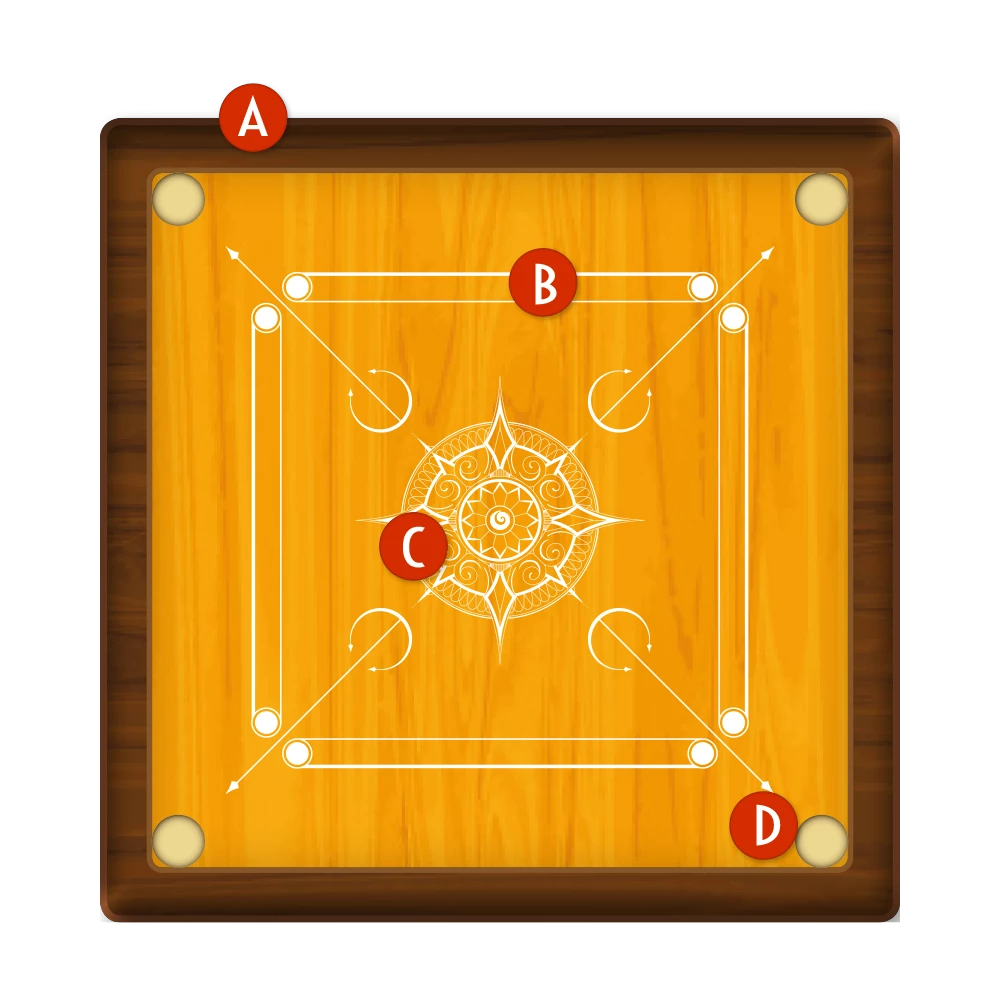
A: rall
B: shooting lines
C: center circle
D: corner pocket
A: rall
B: shooting lines
C: center circle
D: corner pocket
3. THE GAME
In this section, we explain the simple carrom rules. Other game variants are explained in the next section. This game variant is suitable for 2 players. The aim is to pocket your carrom-men before your opponent, while also pocketing and covering the queen for bonus points.
3. DAS SPIEL
In diesem Teil stellen wir die Grundregeln von Carrom dar. Die anderen Spielvarianten werden in dem 4. Teil de–tailiert. Nach den grundlegendsten Regeln wird Carrom von 2 Spieler gespielt. Das Ziel des Spieles ist, dass deine eigenen Spielsteine eher als die des Gegners in die Löcher geschossen werden. Außerdem musst du auch die Köni–gin abstoßen und mit einer deiner Spielsteine bedecken um Plus-Punkte zu bekommen.
Set-up
All 19 carrom-men (9 white, 9 black, 1 queen) have to be set up in the center circle. To begin, the Queen is placed in the centre of the board.
Six pieces are put around the Queen directly in a circle, each touching the Queen and their neighbours. The remaining twelve pieces are positioned around the inner circle of six pieces, so that each outer piece touches the inner circle. Both circles should have the pieces alternating in colour. The two circles are oriented so that the Queen, a white piece from the inner circle and a white piece from the outer circle lie in a straight line pointing towards the center of the side of the board where the player who will play first is sitting.
VORBEREITUNGEN
Platziere alle 19 Carrom-Scheiben (9 Schwarze, 9 Weiße, 1 Rote) in dem Mittelkreis! Zuerst muss die Königin – die rote Scheibe –genau in die Mitte des Spielbrettes gestellt werden.
Zweitens kommen 6 Scheiben in einen Ring herum, diese berühren einander und die Königin. Als letztes folgen die restlichen 12 Scheiben die einen erneuten Ring bilden. Die Scheiben im äußeren Ring müssen einander und den inneren Ring berühren. In die beiden Ringe folgen die weißen und die schwarzen Schei–ben immer wechselweise. Beachtet bei den bei den die Königin und jeweils eine-eine weiße Scheibe aus den beiden Außenringen eine Linie erzeugen müssen, die genau in die Richtung des Startspielers zeigt.

CHOOSING FIRST PLAYER
The players now have to choose the first player, who will be the white player. The official way to choose is called the „toss”: an umpire hides a carrom-men in one of his hands, and the players have to guess which hand he’s hidden it. The player who guesses correctly becomes the first player, or now has the opportunity to change sides from white to black and give up the opening shot.
BESTIMMUNG DES STARTSPIELERS
Die Spieler müssen jetzt entscheiden wer der Start–spieler sein soll, beziehungsweise, wer mit den weißen Spielsteinen sein wird. Die Offizielle Methode für dies ist der sogenannte ,,Aufwurf“: eine neutrale Person versteckt einen Spielstein in einer seiner Hände, und einer der Spieler tippt, in welchem der Stein ist. Wenn er erfolgreich ist kann er entscheiden, ob er anfangen will oder mit den schwarzen Scheiben spielen wird. Wenn er es falsch geraten hat, kann der Gegner diesel–be Entscheidung treffen.
4. GAMEPLAY
Shooting:
The players have to use their striker – the larger disc – to shoot their carrom-men into the pockets.
When placing the striker on the board to shoot, the striker must touch both shooting lines, either covering the circle at the end of the lines completely, or not touching it at all. The striker may not touch the diagonal arrow line.
4. SPIELVERLAUF
Schuss:
Während des Spiels müssen die Spieler mit Hilfe des Strikers , dem Schußstein – die größere Scheibe-dieeigenen Spielsteine -kleinere Scheiben- in die Löcher stoßen.
Wenn ein Spieler den Striker zum Schuss vor sich legt, muss der Striker beide Grundlinien berühren. Wenn der Spieler vom Ende der Grundlinien schießen will, muss der Striker den dort befindenden Kreis genau abdecken. Der Schuss ist ungültig, wenn er den Kreis nur zum Teil abdeckt, oder die diagonale Linie berührt.
The players may use any of their fingers, including their thumb for shooting. However, no parts of the players’ body except their hands may cross the diagonal line or its imaginary extension.
Die Spieler können zu dem Schuss ihre Finger benutzen, einschließlich ihren Daumen. Kein Körperglied–auch die Hand – des Spielers darf die diagonale Linien, oder dessen imaginäre Verlängerung überschreiten.
Pocketing:
- If you pocket one of your carrom-men, you are entitled to shoot again.
- The queen (the red piece) can be pocketed any time after pocketing your first carrom-men, and must be pocketed before you pocket your last piece.
- After pocketing the queen, you must immediately „cover” it by pocketing one of your own carrom-men in the same or subsequent strike. If you fail to do so, the queen is returned to the center of the table.
- After the queen is covered, whoever clears their pieces first wins the board.
- If you sink your opponent’s piece, you lose your turn. If you sink their last piece, you lose the board and three points.
- If you sink your last piece before the queen, you lose the board, three points and one point for each of your opponent’s pieces left.
- Sinking the striker costs you one piece and your turn. But, if you sink a piece in the same shot, then two come up and you shoot again.
- After sinking the striker, your opponent places the due piece(s) within the center circle. If you haven’t sunk one yet, you owe one.
Versenkung:
- Wenn du es schaffst einen deiner Spielsteine in eines der Löcher zu stoßen bist du nochmal dran!
- Die Königin (rote Scheibe) kannst du jeder Zeit in ein Loch stoßen, nachdem du den ersten Spielstein versenkt hast, oder bevor der letzte Spielstein versenkt wurde.
- Nachdem du die Königin versenkt hast, musst du sie sofort ,,abdecken“. Das kannst du erreichen in dem du auch einen deiner Spielsteine direkt nach der Königin abstößt. Das kann in ein beliebiges Loch geschehen.
- Wenn es nicht gelingt muss die Königin in die Mitte des Spielfeldes gelegt werden und der nächste Spieler ist dran. Wenn die Königin abgedeckt wird gewinnt der-jenige dessen Spielsteine zuerst vom Brett schwinden.
- Wenn du Spielsteine des Gegners versenkst, verlierst du deinen Zug. Wenn du den letzten Spielstein des Geg-ners abgestoßen hast, hast du das Spiel verloren und es werden dir 3 Punkte abgezogen.
- Wenn du deinen eigenen letzten Spielstein abstößt ver-lierst du das Spiel und 3 Punkte , außerdem werden dir nach den restlichen Gegnerischen Scheiben ein-ein Punkt abgezogen.
- Wenn du den Striker in ein Loch schießt, musst du ei nen deiner Spielsteine auflegen und verlierst deinen Zug. Wenn mit dem Striker auch ein Spielstein ins Loch fällt, muss er auf das Brett zurückgelegt werden und außer–dem muss ein weiterer Spielstein auf das Brett gelegt werden, aber in diesem Fall darfst du wieder schnießen.
- Nachdem Abstoß des Strikers wird die Strafscheibe/Straf-scheiben vom Gegner im mittleren Bereich aufgesetzt. Wenn du keine Scheibe hast die du auflegen kannst musst du es später nachholen. (Schuldstein)
Scoring:
The winner of the board scores one point for each of the opponent’s carrom-men still left on the board.
If the winner pocketed and covered the queen, he scores three additional points.
If the loser pocketed and covered the queen, no one scores the extra points.
Punkterechnung:
Der Sieger bekommt einen Punkt nach jeder gegne-rischen Scheibe die auf dem Feld gebliebenen ist.
Wenn der Sieger die Königin ins Loch gestoßen hat be-kommt er 3 Extra Punkte. Wenn der Verlierer die Kö-nigin abgestoßen hat, bekommt niemand weitere Extra- Punkte.
Miscellaneous rules:
If a piece jumps off the board, it is placed on the center spot. If pieces land on end or are overlapping, they are left that way.
If the center spot is partially covered when replacing the queen or a jumped piece, the piece should cover as much red as possible. If totally covered, the piece is placed opposite the next player behind the red spot.
If the striker does not leave both lines, go again. You get three tries to break before losing your turn.
Weitere Regeln:
Wenn eine Scheibe das Spielfeld verlässt muss die Scheibe auf die Mitte des Brettes zurückgelegt werden.
Wenn man die Königin oder die Scheibe eines Spie-lers in den Mittelpunkt zurücksetzen muss, dieser aber besetzt ist, muss die Scheibe so nah zum Mittelpunkt wie es möglich ist gesetzt werden. Diese Scheibe muss am weitesten entfernt von dem Spieler liegen der als nächstes an der Reihe ist und muss hinter den Mittel-punkt gelegt werden.
Wenn der Striker die Grundlinien nicht verlassen hat, kannst du nochmal schießen, das kannst du dreimal nacheinander machen bevor du deinen Zug verlierst.
Let the flicking begin!
Das Spiel kann beginnen!
5. GAME VARIANTS
Team Carrom (4 players)
The rules are the same as above, with the 4 players forming two teams. Teammates sit opposite of eachother, and turn goes around in clockwise order.
Family point Carrom (2-3-4 players)
Family-Point Carrom is a variant that is very popular with the young and old, or when playing with an odd number of players. Players are allowed to pocket carrom men of any colour. The rules are as follows:
- Players can shoot carrom men of any colour.
- The rules of shooting are the same as the base game.
- Black is worth 5 points, White is worth 10, and the queen is worth 25 points.
- The queen has to be covered in the same strike.
- When the board is cleared, the player/team with the most points wins.
Point Carrom (2-3-4 players)
A variant of family point carrom, gameplay is mostly the same with a few exceptions:
- Both black and white carrom men are worth 1 points.
- The queen is worth 3 points.
- The queen has to be covered int he same or subsequent strike.
- The first player to reach 21 points is declared the winner.
- If no player reaches 21 points, the player with the highest points is declared the winner. If the scores are tied, a tie-breaker must be played. Players who are tied select a colour. They are allowed to pocket carrom men of an alternate colour only on rebound.
5. ANDERE SPIELVARIATIONEN
Carrom in teams (4 spieler)
Die Regeln sind dieselben wie im normalen Spiel nur hier bilden die vier Spieler zwei Teams. Die Partner nehmen gegenüber voneinander Platz außerdem werden hier die Spieler im Uhrzeigersinn nach einander schießen.
Punktezählung für familien In Carrom(2-3-4 spieler)
Diese Variante ist sehr beliebt, sowohl bei Jung und Alt, und kann auch mit ungerader Spieleranzahl gespielt werden. In dieser Variante können die Spieler die Carrom-Figuren unabhängig von der Farbe vom Brett stoßen. Die Regeln sind die folgenden:
- Die Spieler können die Carrom-Figuren in belie-bigen Farben in die Löcher schießen.
- Die Regeln die sich auf die Schüsse beziehen blei-ben unverändert.
- Der Abstoß einer schwarzen Scheibe erbringt 5 Punkte, eine weiße Scheibe ist 10 Punkte Wert, und der Abstoß der Königin erbringt 25 Punkte.
- Die Königin muss beim selben Schuss auch abge-deckt werden.
- Wenn das Brett leer ist, siegt der Spieler/ das Team, das mehr Punkte hat.
Carrom um punkte (2-3-4 spieler)
Das ist eine Art des Carrom für die Familie, das heißt dass der Spielverlauf sich dem vorherigen sehr ähnelt, außer einigen Ausnahmen:
- Die schwarzen und weißen Carrom-Figuren brin-gen jeweils einen Punkt.
- Die Königin ist 3 Punkte wert.
- Die Königin muss in den Selben oder dem darauf-folgenden Zug abgedeckt werden.
- Der erste Spieler der 21 Punkte erreicht hat, ist der Sieger.
- Wenn keiner die 21 Punkte erreicht, gewinnt derjenige der die meisten Punkte gesammelthat. Bei einem Unentschieden muss man eine Revanche spielen, in dem die Spieler eigene Farben wählen können.

1. About the game
PitRush is an action-packed game of skills, where players try to capture the pits of the gameboard with their discs in order to earn the most points. Players take shots by flicking their disc with their finger. Opponent discs can be struck off and pits can be taken over by stopping on top of the disc in the pit.
The game can be played in two modes. The Arena mode is for 3-6 players, who shoot simultaneously, and bad shots can be retried without penalty. In the Contest mode 2-4 players shoot one after the other, which offers more space for tactical play, so it gives a greater challenge when played with experienced opponents.
The base set which is enough to play both game modes with the recommended player and disc numbers includes the following:
- game board
- disc removal stick
- 49 discs
- 10 pieces from each of 3 colors
- 8 pieces from the 4th color
- 6 pieces from the 5th color
- 5 pieces from the 6th color
1. A propos du jeu
PitRush est un jeu d’action palpitant qui met à l’épreuve les compétences des joueurs, où ces derniers essaient de capturer les fosses du plateau de jeu avec leurs disques afin de gagner le plus de points possible. Les joueurs effectuent des tirs en lançant leur disque avec leur doigt. Les disques des adversaires peuvent être repoussés et les fosses peuvent être conquises en s’arrêtant sur le dessus du disque dans la fosse.
Le jeu peut être joué en deux modes. Le mode Arène est conçu pour 3 à 6 joueurs, qui tirent simultanément, et les mauvais tirs peuvent être repris sans pénalité. Dans le mode Concours, 2 à 4 joueurs tirent l’un après l’autre, ce qui offre davantage d’espace pour le jeu tactique et constitue un défi plus important lorsqu’il est joué contre des adversaires expérimentés.
Le jeu de base, qui est suffisant pour jouer aux deux modes de jeu avec le nombre recommandé de joueurs et de disques, comprend les éléments suivants :
- Plateau de jeu
- Bâton de retrait des disques
- 49 disques
- 10 disques de chacune des 3 couleurs
- 8 disques de la 4e couleur
- 6 disques de la 5e couleur
- 5 disques de la 6e couleur
1. Das Spiel
PitRush ist ein actiongeladenes Geschicklichkeitsspiel. Die Spieler versuchen, mit ihren Scheiben die Löcher auf dem Spielbrett zu besetzen und bekommen dafür unterschiedlich viele Punkte. Die Spieler können die Scheiben auf dem Spielbrett durch Schnippen bewegen. Sie können andere Scheiben hinauswerfen oder besetzte Löcher durch Abdeckung mit der eigenen Scheibe besetzen.
Es gibt zwei Spielarten: Einerseits gibt es das Arena-Spiel für 3-6 Personen. Hier schießen die Spieler gleichzeitig, und die schief gelaufenen Schüsse können ohne Strafe wiederholt werden. Das Wettkampf-Spiel für 2-4 Personen bietet mehrere taktische Möglichkeiten, hier schießen die Spieler wechselweise. Das Wettkampf-Spiel ist weniger ausgeglichen, da es schwieriger ist, gegen geübte Spieler zu spielen.
Mit der Grundausrüstung kann jede Spielart mit der empfohlenen Anzahl an Spielern und Scheiben gespielt werden:
- Spielbrett
- Stock (um die Scheibe herauszunehmen)
- 49 Scheibenjeweils
- 10 Stück in 3 Farben
- 8 Stück in 4. Farben
- 6 Stück in 5. Farben
- 5 Stück in 6. Farben
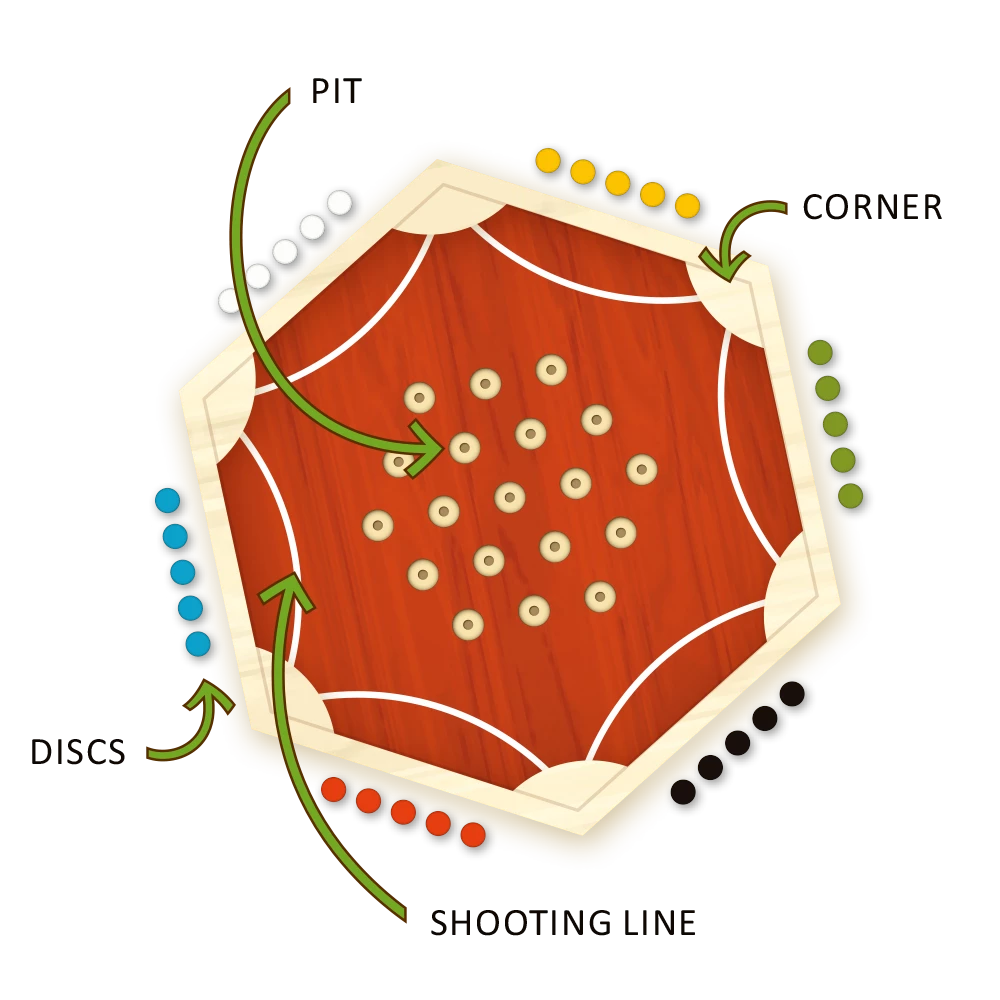
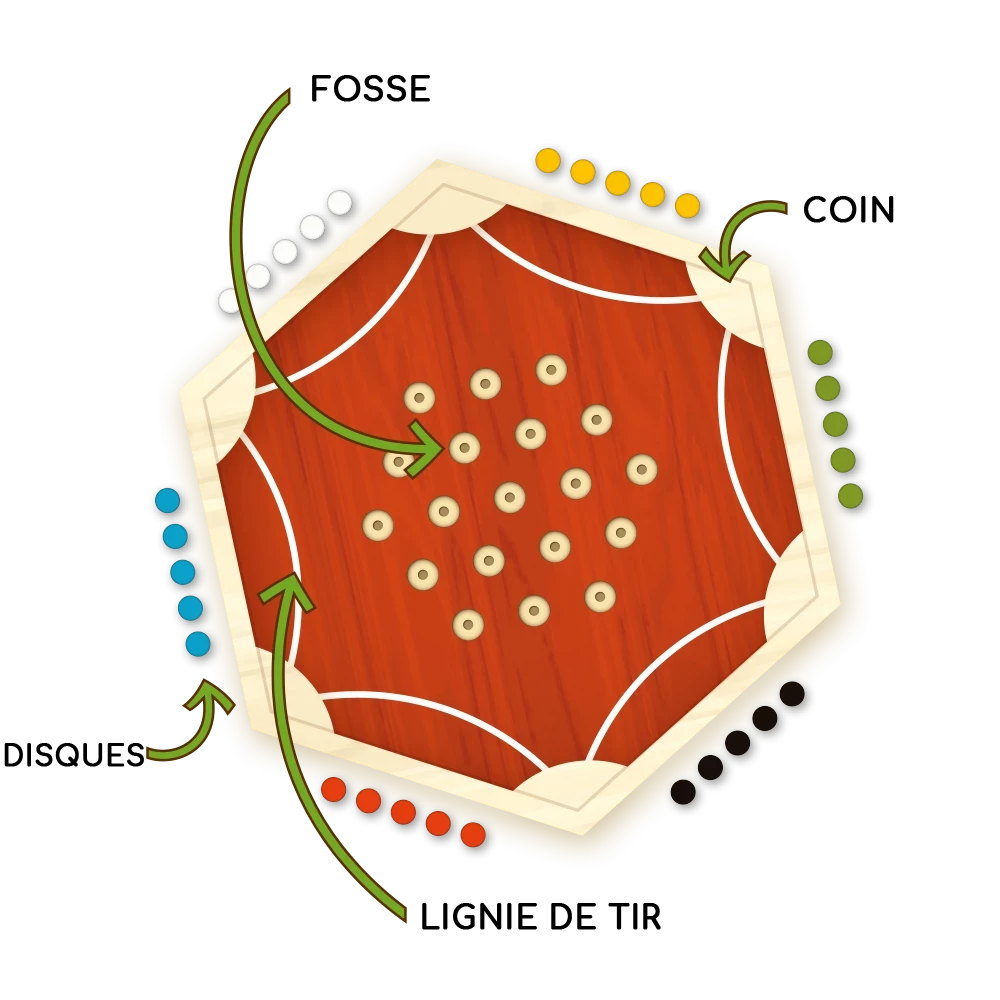
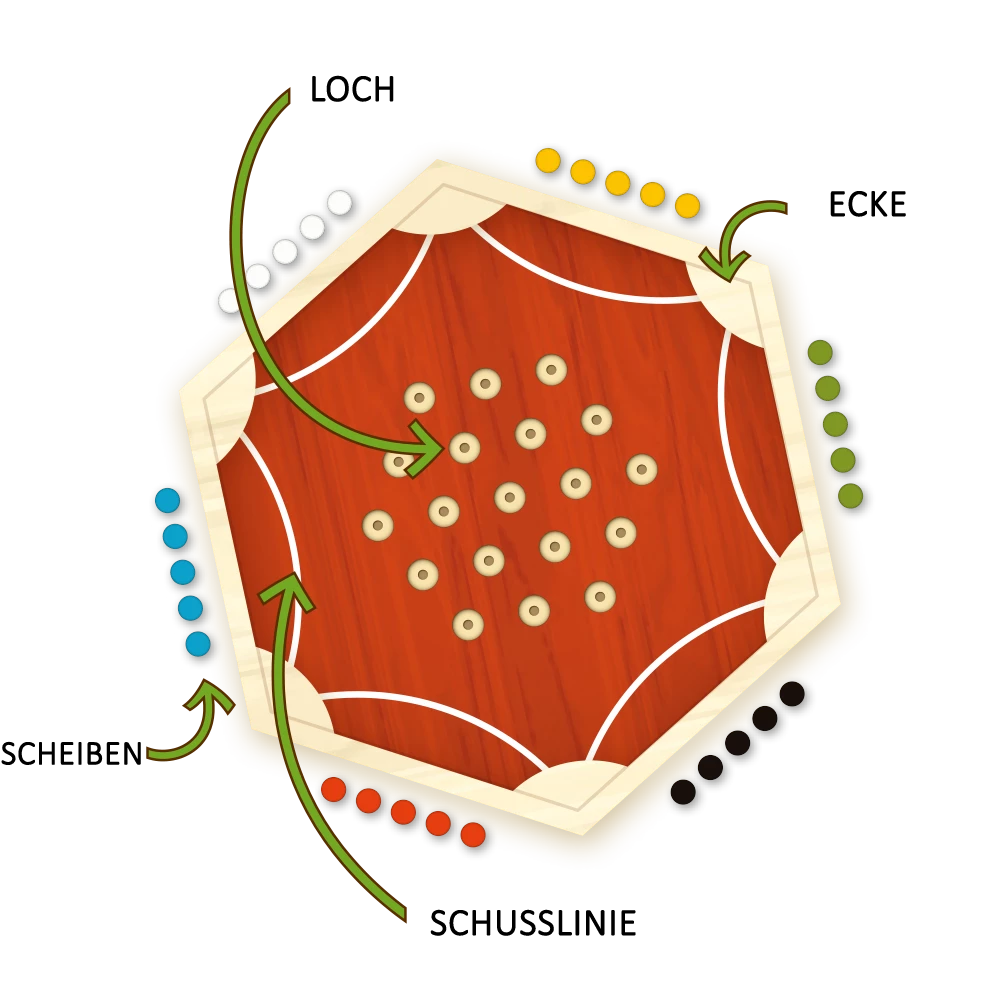
2. Arena mode (3-6 players)
In the Arena mode, a match consists of two game phases and a scoring. Depending on the number of players, everyone starts with a number of discs, as shown in the following image.
Warning! Some of the colors have fewer disks, they can only be used when more players play.
Every player puts their discs in front of themselves on the table, outside the board.
2. Mode arène (3-6 joueurs)
Dans le mode Arène, un match se compose de deux phases de jeu et d’un système de notation. En fonction du nombre de joueurs, chacun commence avec un certain nombre de disques, comme indiqué dans le tableau ci-dessous.
Attention ! Certaines couleurs ont moins de disques, elles ne peuvent être utilisées que lorsque plus de joueurs participent.
Chaque joueur place ses disques devant lui sur la table, à l’extérieur du plateau de jeu.
2. Arena-Spiel (3-6 Spieler)
Im Arena-Modus besteht ein Spiel aus zwei Spielphasen und einer Wertung. Abhängig von der Anzahl der Spieler beginnt jeder mit einer bestimmten Anzahl von Scheiben, wie im folgenden Bild dargestellt.
Von einigen Farben gibt es weniger Scheiben, daher kann man sie nur nutzen, wenn es mehrere Spieler gibt.
Vor dem Spiel legt jeder Spieler seine Scheiben außerhalb des Brettes auf den Tisch.



Phase I.
Choose a starting player whose shot will start the game. After this first shot, every player can shoot anytime, independently from others’ shots. The aim of this phase is to occupy as many pits as possible. The following rules restrict shooting:
- Discs must be flicked from the shooting line (touching the line before the shot).
- If a player has ran out of discs outside of the board, player can take back a disc of his own from the board, which is not in a pit, and shoot with that. Only one disc can be taken back at a time.
- Players can always remove other discs from their shooting area to make room for shooting. The removed discs must be placed on one of the corners of the rail.
Phase I.
Choisissez un joueur de départ dont le tir débutera la partie. Après ce premier tir, chaque joueur peut tirer à tout moment, indépendamment des tirs des autres. L’objectif de cette phase est d’occuper autant de fosses que possible. Les règles suivantes restreignent les tirs :
- Les disques doivent être lancés depuis la ligne de tir (en touchant la ligne avant le tir).
- Si un joueur n’a plus de disques à l’extérieur du plateau, il peut reprendre un de ses disques qui n’est pas dans une fosse et tirer avec. Seul un disque peut être repris à la fois.
- Les joueurs peuvent toujours retirer d’autres disques de leur zone de tir pour faire de la place pour le tir. Les disques retirés doivent être placés sur l’un des coins du rail.
I. Phase
Wählt den ersten Spieler aus, das Spiel beginnt mit seinem Schuss. Dann darf jeder Spieler unabhängig voneinander schießen, man muss nicht auf einander warten. Es gelten die folgenden Regeln fürs Schießen:
- Die Scheibe muss von der Schusslinie aus starten und so platziert werden, dass sie die Linie berührt.
- Wenn jede Scheibe eines Spielers auf dem Brett liegt, kann er eine (aber nur eine!) seiner Scheiben, die nicht in einem Loch liegt, (auch von der Ecke) zurücknehmen, um mit ihr zu schießen.
- Die Spieler dürfen jederzeit jene Scheiben weglegen, die auf oder hinter ihrer Schusslinie liegen, um sich beim Schießen nicht zu behindern. Die Scheiben müssen an die Ecke gelegt werden.
Phase II.
Once every pit is filled with a disc, Phase II begins. Players gather their discs which are not inside pits. After that, beginning with the starting player, going clockwise, players take turns to shoot one of their gathered discs.
If a player has no more discs to shoot, the play continues with the next player. When every player has made a shot with all their discs, Phase II is finished.
While in Phase I the players aim to shoot their discs into the pits, in Phase II there are no empty pits. Players should try to take over pits by stopping their discs on the top of the one in the pit. This way, you can score more points and make your opponents score less.
Discs inside a shooting area or touching a shooting line can still be removed but these discs go out of the game, their owner can’t shoot with them again.
Phase II.
Une fois que chaque fosse est remplie d’un disque, la Phase II commence. Les joueurs rassemblent leurs disques qui ne sont pas à l’intérieur des fosses. Ensuite, en commençant par le joueur de départ et en allant dans le sens des aiguilles d’une montre, les joueurs se relaient pour tirer un de leurs disques rassemblés.
Si un joueur n’a plus de disques à tirer, le jeu continue avec le joueur suivant. Lorsque chaque joueur a effectué un tir avec tous ses disques, la Phase II se termine.
Tandis que dans la Phase I, les joueurs visent à tirer leurs disques dans les fosses, dans la Phase II, il n’y a pas de fosses vides. Les joueurs devraient essayer de prendre le contrôle des fosses en s’arrêtant au-dessus du disque qui se trouve dans la fosse. De cette manière, vous pouvez marquer plus de points et faire en sorte que vos adversaires en marquent moins.
Les disques à l’intérieur d’une zone de tir ou touchant une ligne de tir peuvent toujours être retirés, mais ces disques sortent du jeu, et leur propriétaire ne peut plus tirer avec eux par la suite.
II. Phase
Wenn in jedem Loch eine Scheibe liegt, beginnt die II. Phase. Jeder Spieler nimmt jene Scheiben, die nicht in einem Loch liegen, hervor. Dann kann (beginnend mit dem ersten Spieler) jeder Spieler im Uhrzeigersinn jeweils eine Scheibe schießen.
In der II. Phase gibt es keine leeren Löcher mehr, also ist das Ziel, die Scheiben in den Löchern mit den eigenen Scheiben abzudecken. So wird versucht, weitere Punkte zu bekommen oder Punkte voneinander wegzunehmen.
Die Scheiben, die in der II. Phase geschossen wurden, darf man nicht mehr zurücknehmen. Jene, die auf dem Spielfeld liegen, dürfen zur Seite gelegt werden. Schießen darf man diese Scheiben aber nicht mehr.
Wenn ein Spieler keine Scheiben mehr hat, kann er nicht mehr schießen. Die II. Phase ist beendet, wenn den Spielern alle Scheiben ausgegangen sind.
Scoring
A disc inside a pit (or on top of another disc) scores points to the owner of the disc. The further is the disc from the shooting line the more points it’s worth: the closest pit is worth 1 point, the next three pits 2, and so on, the furthest pits are worth 5 points. The points are shown on the figure:
Notation
Un disque à l’intérieur d’une fosse (ou au-dessus d’un autre disque) rapporte des points à son propriétaire. Plus le disque est éloigné de la ligne de tir, plus il vaut de points : la fosse la plus proche vaut 1 point, les trois fosses suivantes valent 2 points, et ainsi de suite. Les fosses les plus éloignées valent 5 points. Les points sont indiqués sur la figure ci-dessous :
Bewertung
Die Spieler bekommen je nach Entfernung unterschiedlich viele Punkte für teilweise oder gänzlich besetzte Löcher. Für das nächstgelegene Loch (von der Schusslinie des Spielers aus gesehen) bekommt man 1 Punkt, die nächsten drei Löcher zählen 2 Punkte, usw. Die am weitesten entfernten Löcher zählen5 Punkte, wie das Bild zeigt:
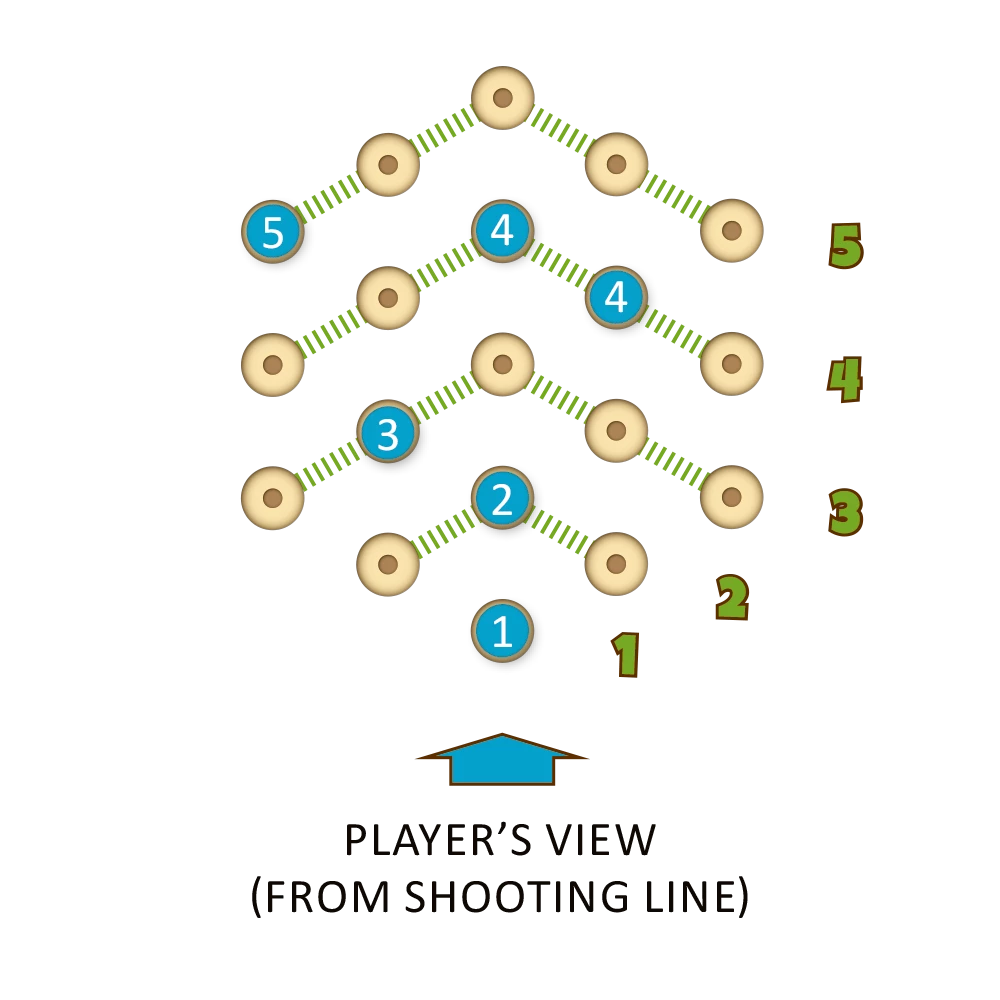
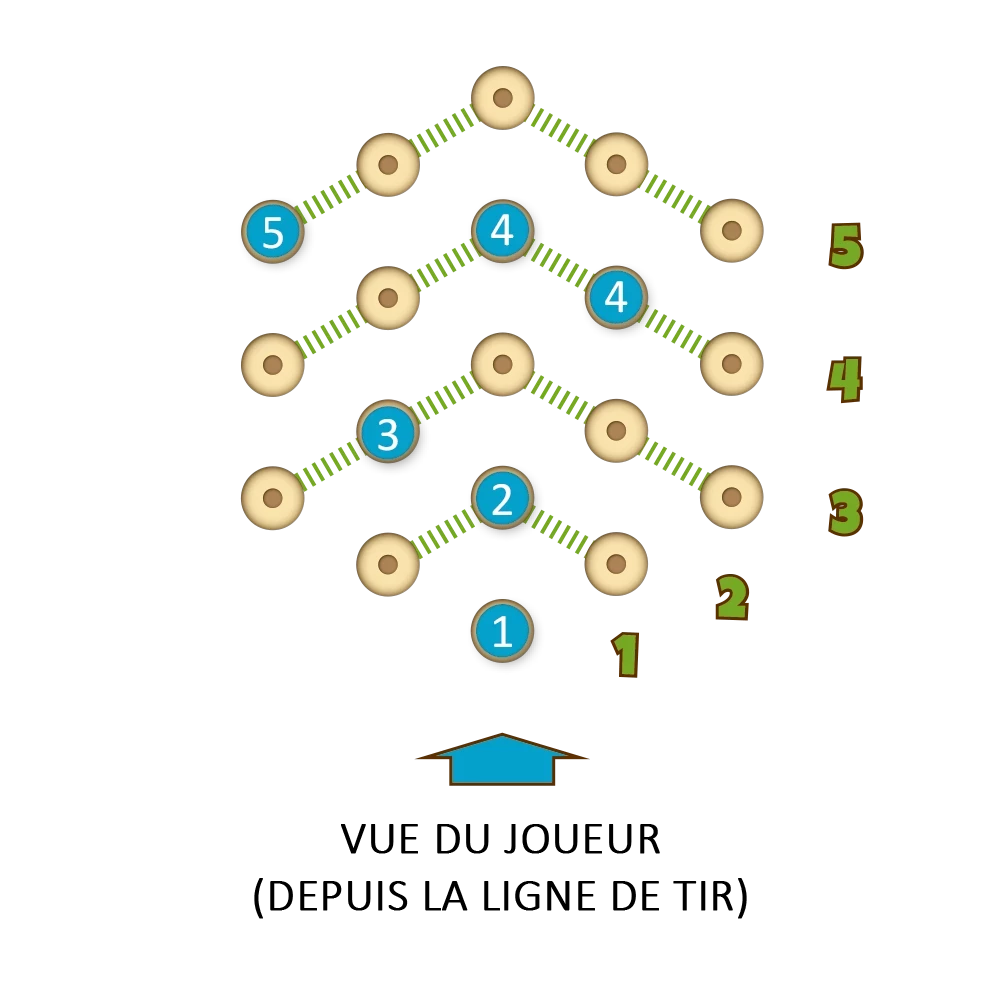
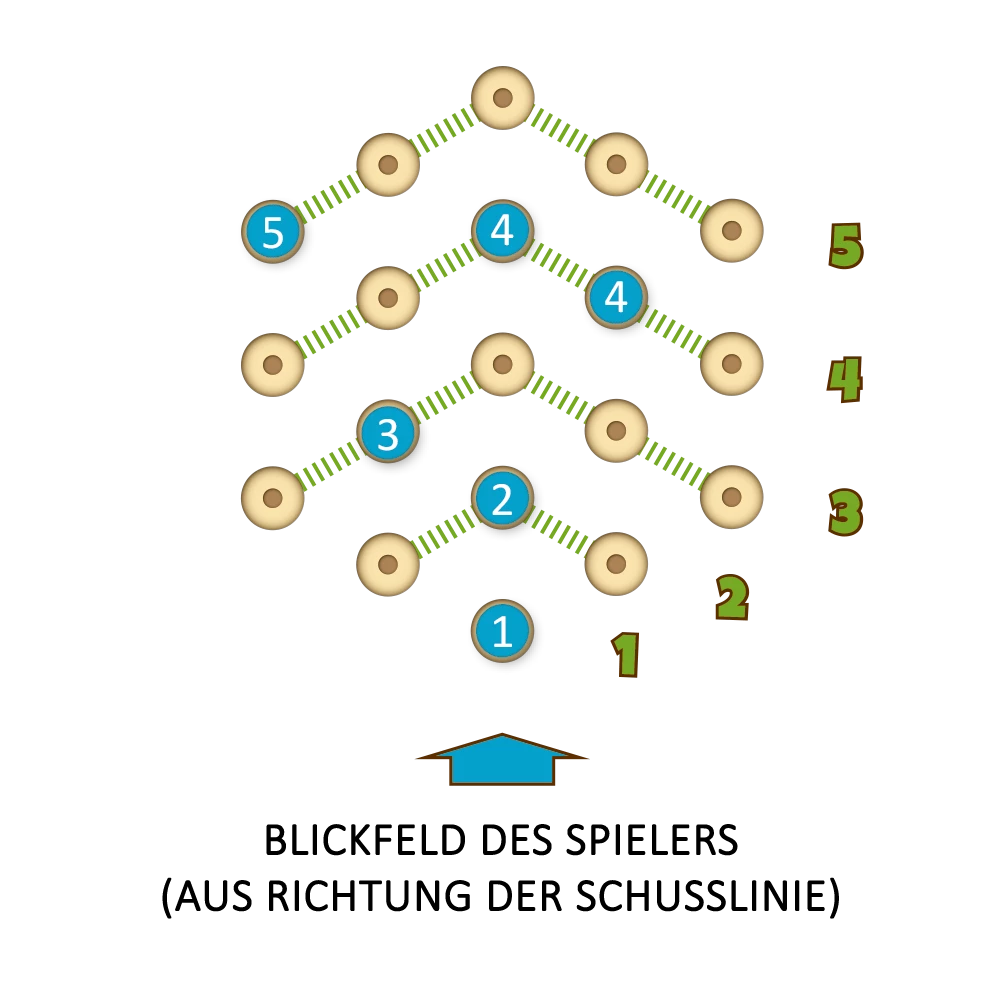
When children are playing who have difficulties to follow these scoring rules, they can use a simpler method where every pit is worth 1 point.
A disc can score points to its owner in two ways:
Wenn Kindern das Punktezählen schwerfällt, geht es auch einfacher: Alle Scheiben an oder in einem Loch zählen 1 Punkt.
Ein Spieler bekommt einen Punkt für seine Scheibe, wenn:
A
Player’s disc is inside a pit, and no opponent disc is on the top of it (own discs can be on it).
A
Le disque du joueur se trouve à l’intérieur d’une fosse, et aucun disque de l’adversaire ne se trouve sur le dessus de celle-ci (ses propres disques peuvent s’y trouver).
A
Die Scheibe im Loch liegt, und es keine Scheibe von anderen Spielern gibt, die seine Scheibe abdeckt (nur die eigene zählt in diesem Fall als Punkt).
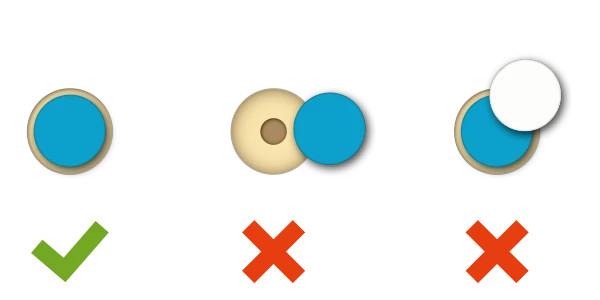
B
The disc is on top of another (any colored) disc inside a pit. It doesn’t matter if other discs are on the top too. If a player has more than one disc on the top, he or she scores the points for each discs.
B
Le disque est placé sur un autre disque (de n’importe quelle couleur) à l’intérieur d’une fosse. Le fait que d’autres disques se trouvent également sur le dessus n’a pas d’importance. Si un joueur a plus d’un disque sur le dessus, il marque les points pour chaque disque.
B
Eine oder mehrere Scheiben (zumindest teilweise) ein besetztes Loch abdecken, unabhängig von der Farbe der Scheibe, die in der Lücke liegt.
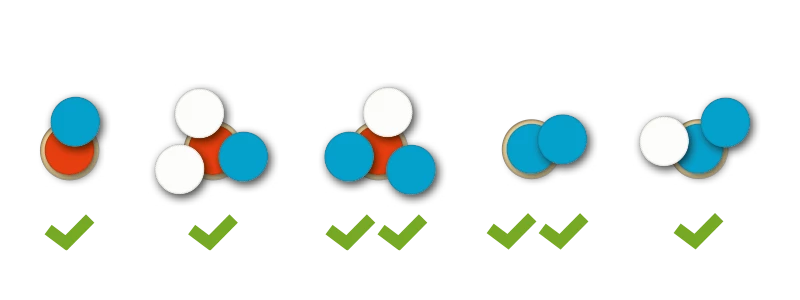
If you want more competition, write down the scores of each player after every match and compare the final scores after a previously decided number of matches (5 is recommended).
Si vous voulez plus de compétition, notez les scores de chaque joueur après chaque match et comparez les scores finaux après un nombre de matchs déterminé à l’avance (5 sont recommandés).
Wenn ihr euch messen wollt, könnt ihr am Ende einer Runde die Ergebnisse auf das Bewertungsblatt schreiben. Wir empfehlen 5 Runden, am Ende gewinnt der Spieler mit den meisten Punkten.
3. Contest mode (2-4 players)
In the Contest mode, a match consists of two game phases and a scoring, just like in Arena mode but the rules of the phases are different. Depending on the number of players, everyone starts with a number of discs shown on the following image:
3. Mode de Concours (2-4 joueurs)
Dans le mode de Concours, un match se compose de deux phases de jeu et d’une notation, tout comme dans le mode Arène, mais les règles des phases sont différentes. En fonction du nombre de joueurs, chacun commence avec un certain nombre de disques, comme indiqué dans le tableau ci-dessous.
3. Wettkampf-Spiel (2-4 Spieler)
Das Wettkampf–Spiel besteht, ähnlich wie das Arena-Spiel, aus zwei Phasen und der Bewertung. Die Regeln in den Phasen sehen jedoch anders aus. Diese Tafel zeigt die Zahl der Scheiben für die jeweilige Anzahl der Spieler.



In a 4-player game, it is recommended to use the colors with the least number of disks to make sure that enough neutral disks remain.
Every player puts their discs in front of themselves on the table, outside the board. The discs of the remaining colors will be used as neutral discs.
Dans une partie à 4 joueurs, il est recommandé d’utiliser les couleurs ayant le moins de disques pour s’assurer qu’il reste suffisamment de disques neutres.
Chaque joueur place ses disques devant lui sur la table, à l’extérieur du plateau. Les disques des couleurs restantes seront utilisés comme disques neutres.
Bei 4 Spielern wird empfohlen, die Farben mit weniger Scheiben zu wählen, damit bestimmt genug neutrale Scheiben übrig bleiben.
Vor dem Spielbeginn legt jeder Spieler seine Scheiben außerhalb des Spielbretts auf den Tisch. Die weiteren Scheiben werden später auch benötigt, sie gelten dann als neutral.
Phase I.
Choose a starting player who takes the first shot. After that, players take turns in a clockwise order, shooting one by one.
Contrary to Arena mode, the discs not in pits won’t be removed at the end of the phase. Because of this, players can aim to take over filled pits even in Phase I. This comes in handy when you try to create formations which will be described at the scoring section.
Phase I.
Le joueur de départ doit être choisi de manière arbitraire, et c’est lui qui effectuera le premier tir. Ensuite, les joueurs peuvent tirer à tour de rôle dans le sens des aiguilles d’une montre, de la même manière que dans la Phase II du mode Arène.
Contrairement au mode Arène, les disques qui ne sont pas dans les fosses ne seront pas retirés à la fin de la phase. En raison de cela, les joueurs peuvent viser à prendre le contrôle des fosses remplies même en Phase I. Cela s’avère utile lorsque vous essayez de créer des formations qui seront décrites dans la section de notation.
I. Phase
Wählt den ersten Spieler aus, das Spiel beginnt mit seinem Schuss. Danach schießen die Spieler im Uhrzeigersinn nacheinander, ähnlich wie in II. Phase vom Arena–Spiel.
Entgegen dem Arena-Spiel werden die nicht in einer Lücke liegenden Scheiben am Ende der Phase nicht vom Spielfeld genommen. Also ist das Ziel nicht nur, dass eine Scheibe in einem Loch landet, sondern auch die Abdeckung der bereits besetzten Löcher. Die Spieler sollen außerdem versuchen, verschiedene Formationen aufzubauen. (Diese werden im Kapitel zur Bewertung genauer erklärt.)
Phase II.
The disc is on top of another (any colored) disc inside a pit. It doesn’t matter if other discs are on the top too. If a player has more than one disc on the top, he or she scores the points for each discs.
After players have shot their last disc, Phase II begins. The game continues by taking turns but since they don’t have discs, they must take back one of their discs which is not inside a pit and take a shot with that. The following action is taken depending on this shot:
Phase II.
Après que les joueurs ont tiré leur dernier disque, la Phase II commence. Le jeu se poursuit en prenant des tours, mais comme ils n’ont plus de disques, ils doivent reprendre l’un de leurs disques qui n’est pas dans une fosse et tirer avec. L’action suivante dépend de ce tir :
II. Phase
Wenn alle Scheiben von jedem Spieler auf dem Brett liegen, beginnt die II. Phase. Es beginnt der erste Spieler und die bisherige Reihenfolge wird weiter eingehalten. Die Spieler nehmen eine eigene Scheibe, die nicht in einem Loch liegt, und schießen wieder. Abhängig davon, wie geschossen wurde, kann sich das Spiel auf zwei verschiedene Weisen fortsetzen:
A
If any disc fell into a pit (own or opponent disc), nothing special happens, the next player’s turn follows.
A
Si l’un des disques est tombé dans une fosse (qu’il s’agisse du disque du joueur ou de celui de l’adversaire), rien de spécial ne se produit, et le tour du joueur suivant s’ensuit.
A
Wenn nach dem Schuss irgendeine Scheibe (die eigene oder eine andere) in ein Loch fällt, passiert nichts, es kommt der nächste Spieler dran.
B
If none of the discs fell into any of the pits, the next player has to put a neutral disc into an empty pit (he or she chooses) before starting the next turn.
B
Si aucun des disques n’est tombé dans l’une des fosses, le joueur suivant doit placer un disque neutre dans une fosse vide (qu’il ou elle choisit) avant de commencer le tour suivant.
B
Wenn nach dem Schuss keine Scheibe in ein Loch fällt, muss der Spieler vor dem Zug des nächsten Spielers eine neutrale Scheibe in ein Loch legen (er entscheidet, wohin). Dies ist nur dort erlaubt, wo keine Scheibe auch nur zum Teil ein Loch abdeckt.
If a disc is hanging on the edge of an empty pit (even covers a little part of the pit), no neutral disc can be placed into that pit.
Si un disque est en équilibre sur le bord d’une fosse vide (même s’il recouvre légèrement une partie de la fosse), aucun disque neutre ne peut être placé dans cette fosse.
Wenn ein Plättchen am Rand einer leeren Grube hängt (auch wenn es nur einen kleinen Teil der Grube), kann keine neutrale Scheibe in diese Grube gelegt werden
The match ends immediately when any of the following happens:
Le match se termine immédiatement lorsque l’une des situations suivantes se produit :
Das Spiel ist zu Ende:
A
Every pit is filled with a disc.
A
Chaque fosse est remplie d’un disque.
A
Wenn auch im letzten Loch eine Scheibe liegt.
B
A neutral disc has to be placed but there are no valid pits.
B
Un disque neutre doit être placé, mais il n’y a plus de fosses valides disponibles.
B
Wenn eine neutrale Scheibe gelegt werden müsste, das aber regulär nicht möglich ist.
C
All discs of a player are inside pits.
C
Tous les disques d’un joueur se trouvent à l’intérieur des fosses.
C
Wenn alle Scheiben eines Spielers in Löchern liegen.
Scoring
Scoring is similar to the Arena scoring with a few special cases and the formations. The neutral discs aren’t worth points to anyone but the discs on top of them are worth the usual points. Discs hanging on the edge of empty pits aren’t worth any points.
Creating formations is a way to earn extra points. A small triangle is worth +1 point, and a complete row is worth as many points as the number of pits it has. A pit can belong to more than one formations, even to more players.
Notation
Le système de notation est similaire à celui de l’Arène avec quelques cas spéciaux et les formations. Les disques neutres ne rapportent de points à personne, mais les disques placés au-dessus d’eux valent les points habituels. Les disques en équilibre sur le bord des fosses vides ne rapportent aucun point.
Créer des formations est un moyen de gagner des points supplémentaires. Un petit triangle vaut +1 point, et une rangée complète vaut autant de points que le nombre de fosses qu’elle comporte. Une fosse peut appartenir à plusieurs formations, même à plusieurs joueurs.
Bewertung
Die Bewertung funktioniert abgesehen von einigen Spezialfällen ähnlich, wie im Arena-Spiel. Beim Wettkampf-Spiel bringen neutrale Scheiben, die in Löchern liegen, keine Punkte, aber sie können durch Abdeckung sehr wohlbesetzt werden. Für diese Fälle werden wie bisher bekannt Punkte gezählt. Über leere Löcher ragende Scheiben bringen jedoch keinen Punkt.
Man kann außerdem für verschiedene Formationen Bonuspunkte bekommen. Ein kleines Dreieck zählt 1 Bonuspunkt. Jede voll besetzte Reihe zählt so viele Bonuspunkte, wie viele Scheiben in der Reihe liegen. Ein Loch kann gleichzeitig zu mehreren Formationen gehören.
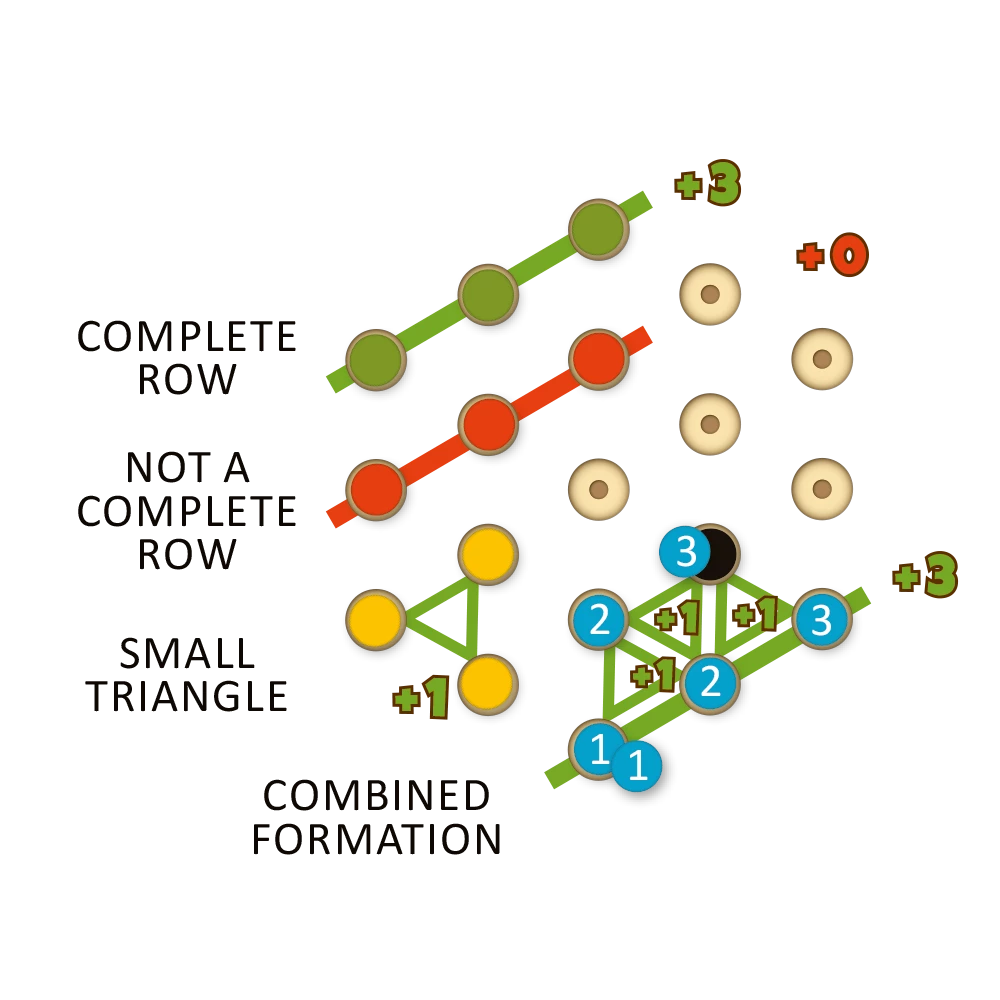
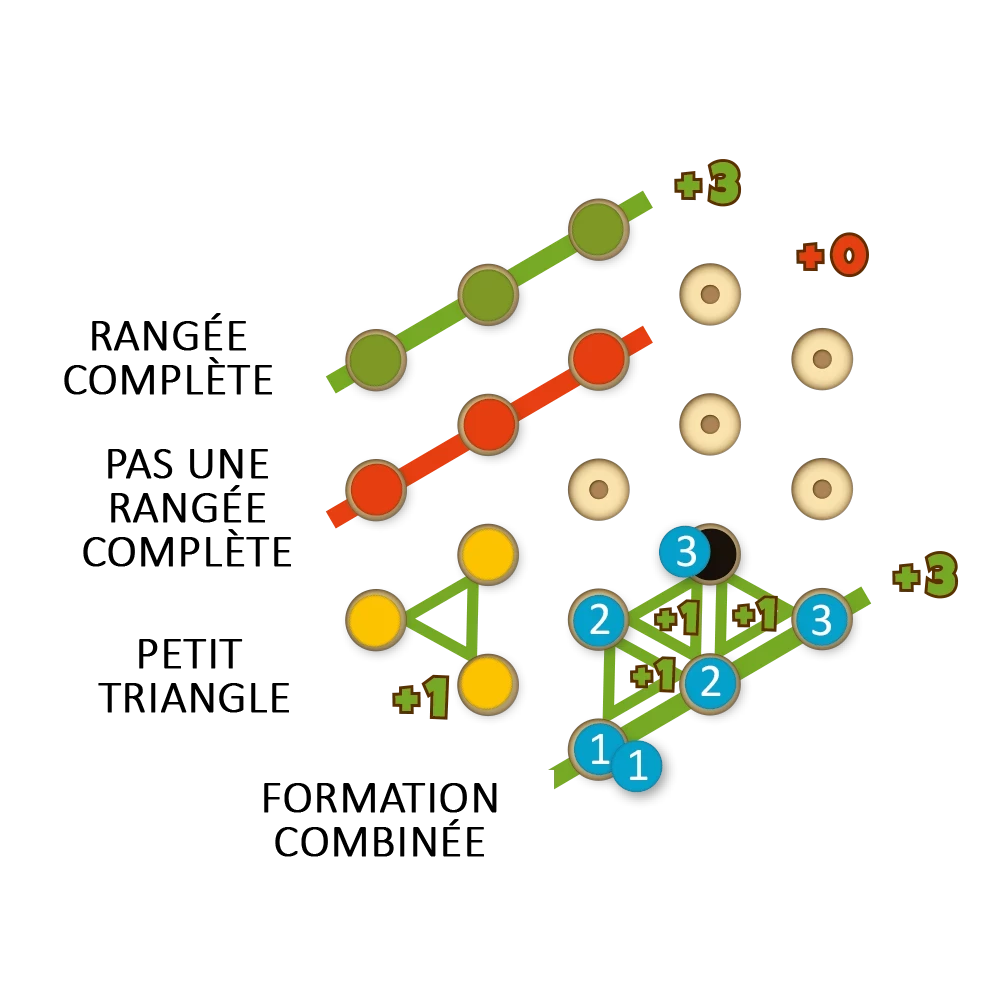
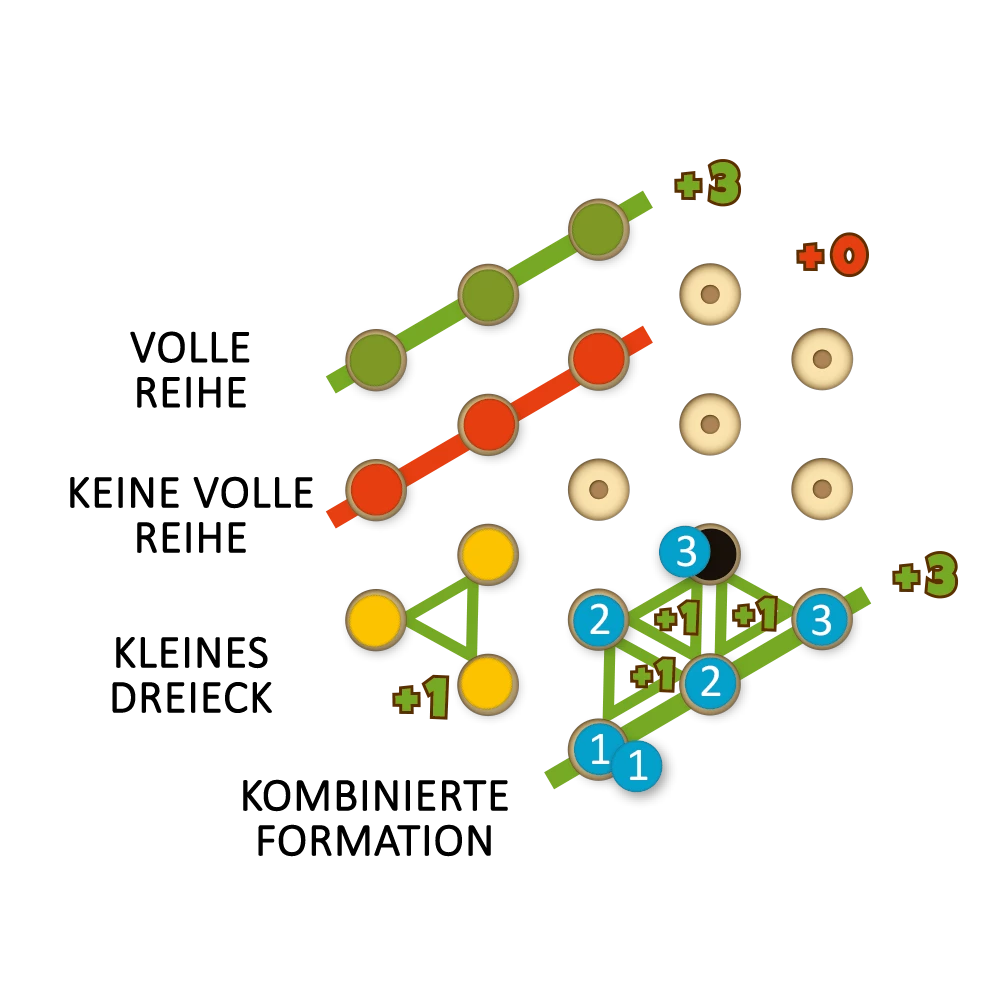
The blue player scores 18 points. White numbers on discs show points earned from the pits, and green numbers for creating formations.
Le joueur bleu marque 18 points. Les chiffres blancs sur les disques représentent les points gagnés à partir des fosses, et les chiffres verts représentent les points pour la création de formations.
Der blaue Spieler hat insgesamt 18 Punkte erreicht. Die weißen Zahlen auf den Scheiben zählen die einfachen Punkte für besetzte Löcher, die grünen Zahlen geben Bonuspunkte für Formationen an.
Let the flicking begin!
Que les pichenettes commencent !
Das Spiel kann beginnen!
4. Frequently asked questions
What if another disc inside my shooting area is obstructing my shot?
Before shooting, remove the obstructing disc and place it on a corner. You can only do this if the disc is inside your shooting area or touching the shooting line. In Arena mode you can do it any time during Phase I. In every other case only if it is your turn.
What to do if a disc flies off the board?
It should be handled like it was removed from a player’s shooting area. If it happened during Phase I of Arena mode, you can ask the other players to wait until you find it.
Are formations worth points in Arena mode?
Formations work better in Contest mode because you have more time to plan your shots there. However, there is no reason why you couldn’t use them in Arena mode, so if you decide on using them before starting the match, have fun with them!
If I have a disc inside a pit and another one on top of it, do I get double points for the formations too?
No, as you can see on the explaining figure, one player can only score points once for a formation. Even if the player has multiple discs on top of all the pits of the formation.
What exactly counts as being on top of a pit?
If the surface of the board is visible between the pit and the disc, then the disc is not on top of the pit. It’s important to note that the disc has to cover part of the pit, not part of the disc inside it.
4. Fréquemment posées questions
Et si un autre disque à l’intérieur de ma zone de tir obstrue mon tir ?
Avant de tirer, retirez le disque obstruant et placez-le dans un coin. Vous ne pouvez le faire que si le disque se trouve à l’intérieur de votre zone de tir ou touche la ligne de tir. En mode Arène, vous pouvez le faire à n’importe quel moment pendant la phase I. Dans tous les autres cas, uniquement si c’est votre tour.
Que faire si un disque s’envole du plateau ?
Il doit être traité comme s’il avait été retiré de la zone de tir d’un joueur. Si cela se produit pendant la phase I du mode Arène, vous pouvez demander aux autres joueurs d’attendre que vous le retrouviez.
Les formations valent-elles des points en mode Arène ?
Les formations fonctionnent mieux en mode Contest car vous avez plus de temps pour planifier vos tirs. Cependant, il n’y a aucune raison pour laquelle vous ne pourriez pas les utiliser en mode Arène, donc si vous décidez de les utiliser avant de commencer le match, amusez-vous avec elles !
Si j’ai un disque à l’intérieur d’une fosse et un autre par-dessus, est-ce que j’obtiens des points doublés pour les formations ?
Non, comme vous pouvez le voir sur la figure explicative, un joueur ne peut marquer des points qu’une seule fois pour une formation. Même s’il a plusieurs disques empilés sur toutes les fosses de la formation.
Qu’est-ce qui compte exactement comme étant au-dessus d’une fosse ?
Si la surface du plateau est visible entre la fosse et le disque, alors le disque n’est pas au-dessus de la fosse. Il est important de noter que le disque doit recouvrir une partie de la fosse, et non une partie du disque à l’intérieur de celle-ci.
4. Häufig gestellte Fragen
Was mache ich, wenn eine Scheibe in meiner Schusslinie oder dahinter liegt?
Lege die Scheibe, die dich stört, vor dem Schuss an die Ecke. Du darfst das nur mit Scheiben in deinem Schussgebiet machen und nur dann, wenn du schießen möchtest – also im Arena-Spiel in I. Phase (zu jeder Zeit), und in allen anderen Phasen dann, wenn du dran bist.
Was passiert, wenn eine Scheibe vom Brett fliegt?
Mit dieser Situation wird umgegangen, als wäre die Scheibe vom Schussfeld des Spielers entfernt worden.
Bekommt man im Arena-Spiel keine Bonuspunkte für Formationen?
Von den Grundregeln ausgehend nicht, aber wenn ihr möchtet, könnt ihr nach Zustimmung aller Mitspieler auch so spielen.
Wenn meine Scheibe in ein Loch hineinragt, in dem sich eine meiner Scheiben befindet, bekomme ich dann gleich wie für das Loch auch für die Formation die doppelte Punktzahl?
Nein, wie die Skizze zeigt, bekommt ein Spieler nur einmal Punkte für Formationen. Selbst dann, wenn er in jedem Loch der Formation zwei Scheiben hat.
Was gilt im Spiel als Abdeckung des Lochs?
Wenn man zwischen den Rändern der Scheibe und des Lochs das Spielfeld sehen kann, dann deckt die Scheibe das Loch nicht ab. Um ein besetztes Loch abzudecken ist es genug, nur über das Loch zu ragen. Es ist egal, ob die zwei Scheiben sich berühren oder nicht.

Game rules
1. About the game
Sling is a fast-paced, hand-eye coordination duel game in which players aim to shoot all the discs into the opponent’s zone as quickly as possible.
Contents of the game
- 1 Sling game board
- 2 Sets of different coloured discs (7+1)
- 2 Scoring sticks
- 1Plasticgate-closingcard
- 1 Glisspowder (20g)
- 2 Spare rubbers
- 1 Game rules
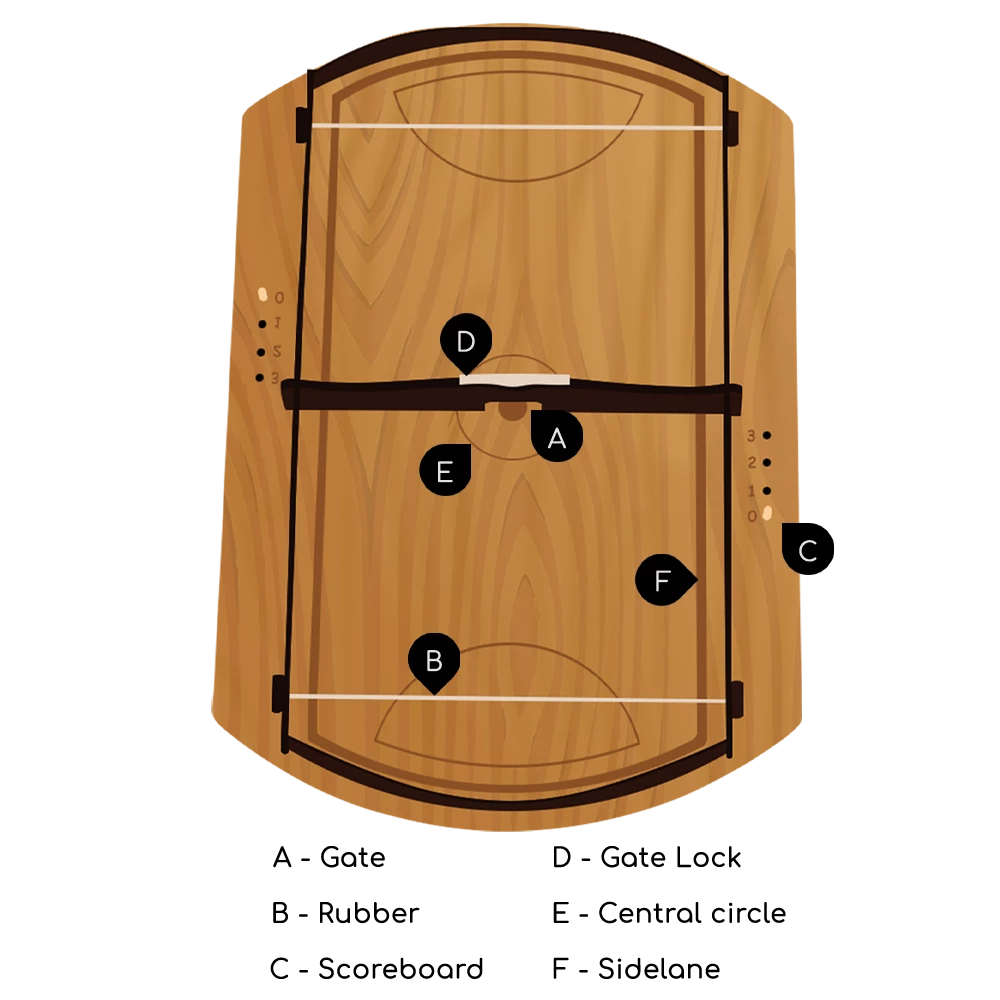
3. Preparing the game
Place the game board on a table , then face each other.
On either side of the board are the scoring bars. Before the game starts, place the scoring sticks in the slots next to the 0 label.
Insert the gate into the slot in the middle of the board in open position.
3. Basic rules
You can use only one of your hand while playing!
- Choose a color from the two disc colors.
- Take them in your hand and release them over your opponent’s side of the board.
- Place one of the discs at the shooting rubber.
- The game starts with a fist bumb!
- Pull back the disc in front of the rubber and shoot it into the opponent’s field. The only way to do this is to shoot the disc trough the gate.
- When all the discs are in the opponent’s half of the board, close the gate to win. (You get 1 point)
However keep in mind, if your opponent manages to shoot a disc to your half of the board before you close the gate you lost the round. (Your opponent gets 1 point)
The game is played in rounds, the first player to collect 3 points wins the game!
Attention! Once the game starts there is no stopping, no waiting around, aim accurately as possible and shoot faster!
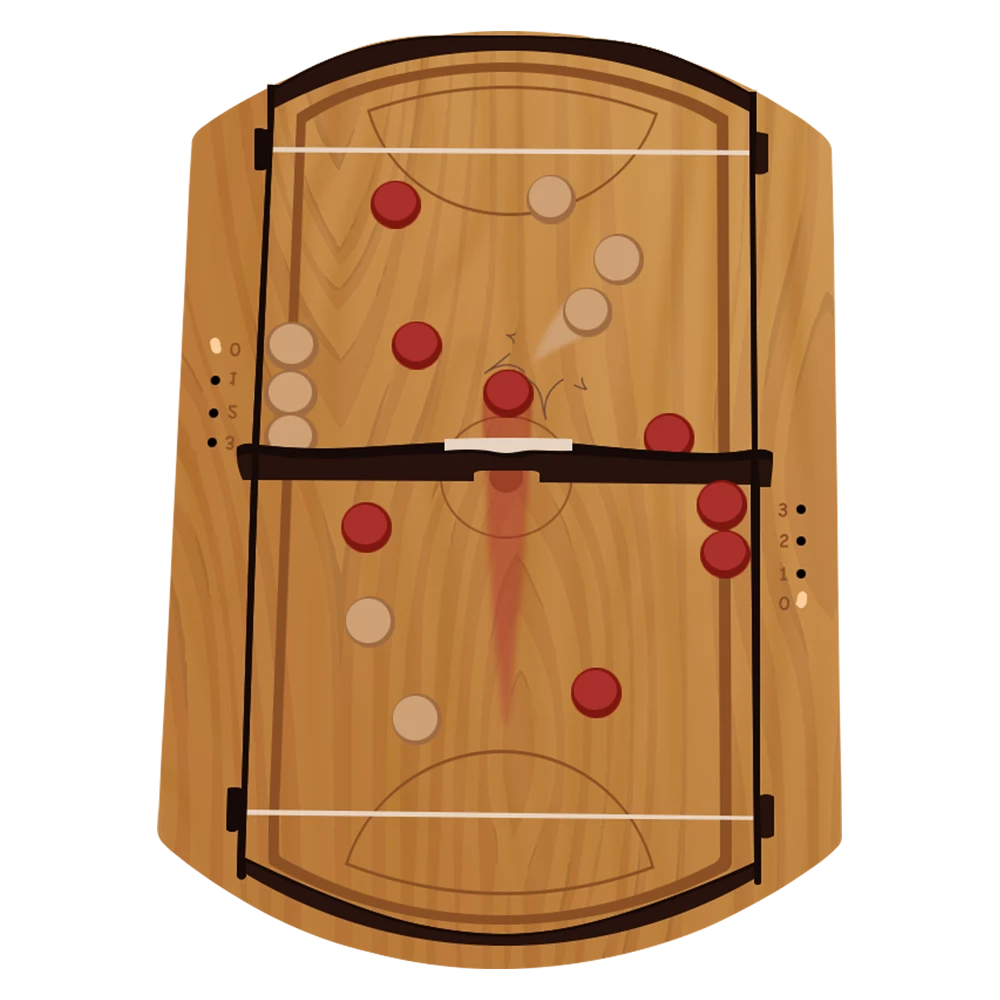
4. Game variations
Slow mode
- Place the discs outside the board.
- The younger player starts the game.
- You’ll shoot once with each disc, one after the other.
- Whoever has more discs left in the opponent’s side wins the round. (1 point)
- In the case of a tie, you must replay that round.
- Whoever scores more points in 3 rounds wins.
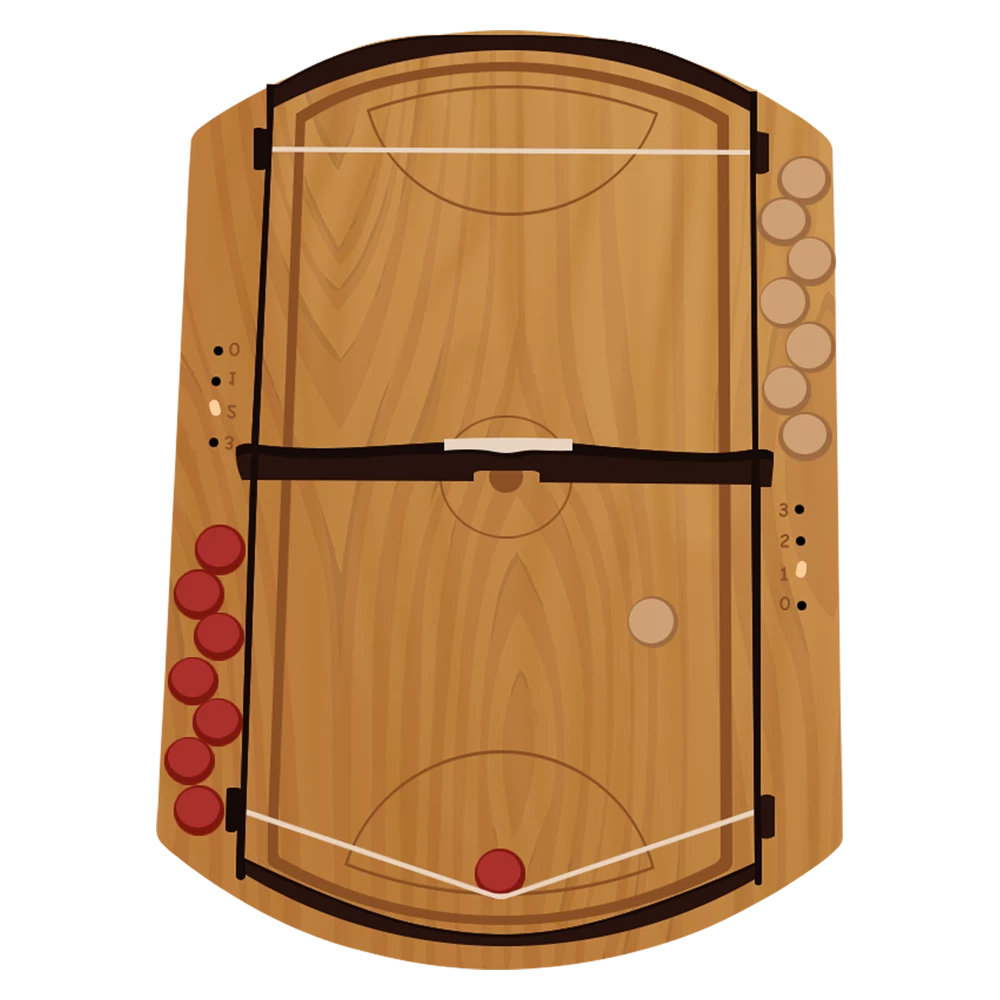
Quickmatch
- You start the game according to the basic rules, but during the game you only need to shoot your own discs into the other player’s side.
- Of course you can also shoot back your opponent’s discs as well!
- When you have shot through all your own discs, close the gate.
- Each win is worth 1 point.
- If your opponent manages to shoot back one of your discs before you close the gate, you lost the round. (Your opponent gets 1 point)
- The first player to score 3 points wins.
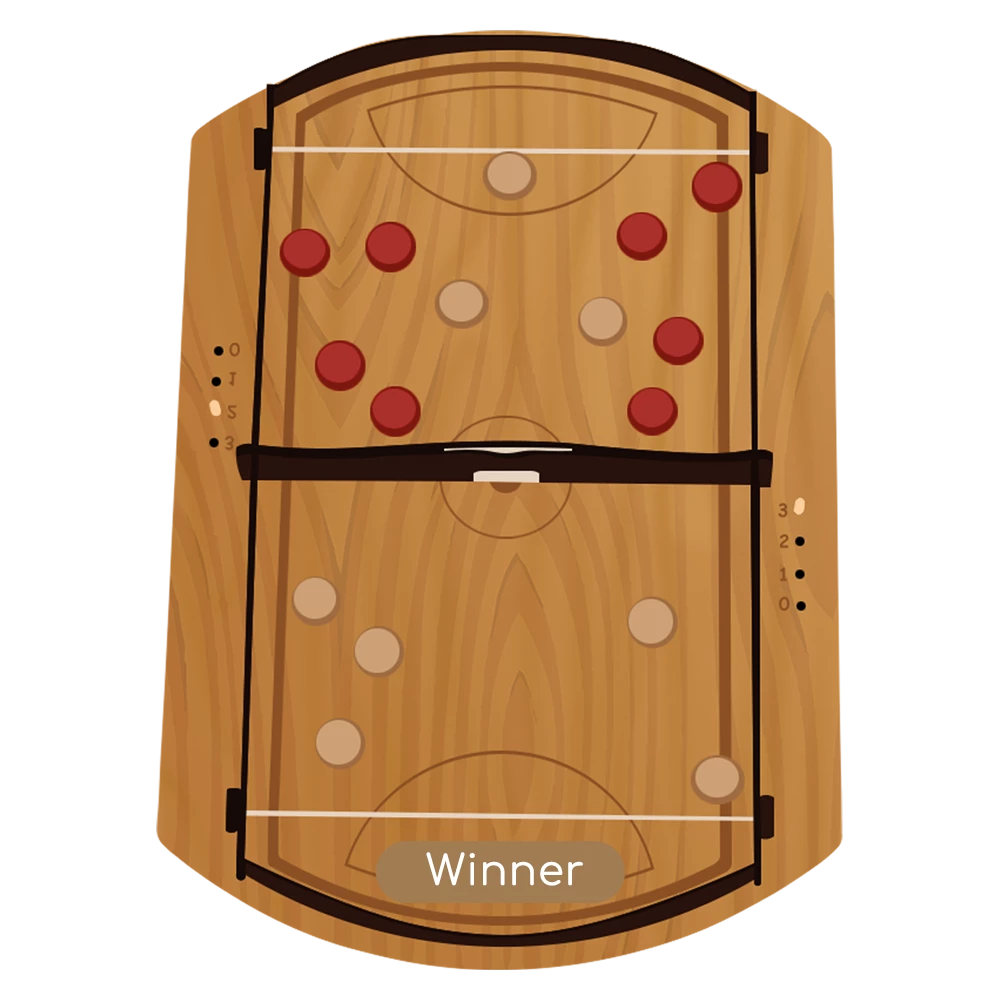
Custom game
In addition to the two game variations mentioned above, feel free to invent your own rules, mixing and matching existing ones.
If you feel you’ve come up with a unique game mode, you can submit it to us and if you do, it will be included in the official game rules along with your name! All you have to do is email us at hello@cogitategames.hu
Let the game begin!
5. Frequently asked question
What to do if a disc bounces off the board?
If a disc falls out off the board, the person who is closest to the disc must IMMEDIATELY pick it up and place it on his/her side of the board.
However, the game does not stop in the meantime!
How can we move the discs?
You can only touch the discs on your own side of the board. The discs should not be lifted during play, but slid on the board. The only place you may not move the discs by hand is into the centre circle, but you can
takethem out of it.
Can we shoot with more than one disc at a time?
Yes, although the chances of at least one of them getting through the gate are pretty small, but you can try.
What to do if a disc gets behind the shooting rubber?
Discs should only be lifted from the playing field in this exceptional case. The disc must be placed on your side on the board.
What to do if the rubber comes off / breaks?
In this rare case, stop the game. Remove the torn rubber from its holder and replace it with a new one. The round must then be played again.
Storing and maintenance of the board!
- Always keep your board in a dry place on room temperature! High degree of humidity may cause bending or warping of the board.
- If water is spilled on the board clean it immediately with a dry soft cloth, because absorbing the water may cause bending or warping of the board!
- Do not expose the board to glaring sun or heat because it can result in crackles of the surface lacquering!
- Do not use open fire near the board! Do not put cigarette on the board!
- Do not place foreign or sharp objects on the board, because it may cause serious scratches on the surface!
- It is highly recommended to use only the proper gliss powders on the board, because other lubricants or powders may cause scratches!
- If the board becomes dusty or dirty use moist (not wet) or dry cloth to clean it!
- Do not use cleaning agent or detergents!
- The manufacturer has the right to refuse responsibility in case of any damage due to improper use of the board and accessories!
- This product contains no detrimental materials to health! Please keep this information for your records!
Stockage et maintenance de la planche!
- Toujours garder votre planche dans un endroit sec à température ambiante! Un degré élevé d’humidité peut provoquer une déformation de la planche.
- Si de l’eau est versé sur la planche, nettoyer immédiatement avec un chiffon doux et sec, l’absorption d’eau pouvant provoquer une déformation de la planche!
- N’exposez pas la planche au soleil ou à la chaleur, cela peut abimer la surface vernie!
- Ne pas allumer de feu ni de cigarette près de la planche!
- Ne placez pas d’objets lourds ou pointus sur la planche, cela peut causer des rayures à la surface!
- It is highly recommended to use only the proper gliss powders on the board, because other lubricants or powders may cause scratches!
- Il est fortement recommandé d’utiliser uniquement la poudre de glisse appropriée sur la planche, d’autres lubrifiants ou poudres pouvant causer des rayures!
- Si le tableau devient sale, utilisez un chiffon doux et sec pour le nettoyer! N’utilisez pas de matériels de nettoyage ou de détergents!
- Le fabricant a le droit de refuser la responsabilité en cas d’endommagement causés par une mauvaise utilisation de la planche ou des accessoires!
- Ce produit ne contient aucun matériau nuisible pour la santé! Gardez cette information pour votre référence.
Aufbewahrung und Instandhaltung des Spielbretts!
- Bei Nichtgebrauch ist das Spielbrett an einem trockenen Ort bei Zimmertemperatur aufzubewahren! Ein zu hohe Luftfeuchtigkeit kann das Spielbrett verformen oder verkrümmen.
- Falls das Spielbrett mit Wasser in Berührung kommt, sollte man es schleunigst mit einem trockenen, weichen Tuch trocknen, um zu vermeiden, dass sich das Holz von eindringendem Wasser verformt oder verkrümmt!
- Setzen Sie es nicht der prallen Sonne aus, da hohe Temperaturen Risse in der Lackbeschichtung verursachen können.
- Verwenden Sie keine offene Flamme in der Nähe des Spielbretts!
- Platzieren Sie – abgesehen von den dazugehörigen Holzscheiben – keine fremden, scharfen Gegenstände auf dem Spielbrett!
- Auf der Spielfläche ist nur das dazugehörige Rutschpulver zu verwenden, da andere Pulver die Oberfläche zerkratzen können!
- Wenn das Spielbrett verstaubt oder verdreckt ist, sollte man es mit einem feuchten (nicht nassen) Tuch abwischen! Verwenden Sie keine aggressiven Reinigungsmittel!
- Der Hersteller haftet für keine Schäden, die durch unsachgemäßen Gebrauch des Spielbretts oder des Zubehörs entstehen!
- Das Produkt beinhaltet keine gesundheitsschädlichen Stoffe! Bitte bewahren Sie dieses Dokument zur Kundeninformation sorgfältig auf!

